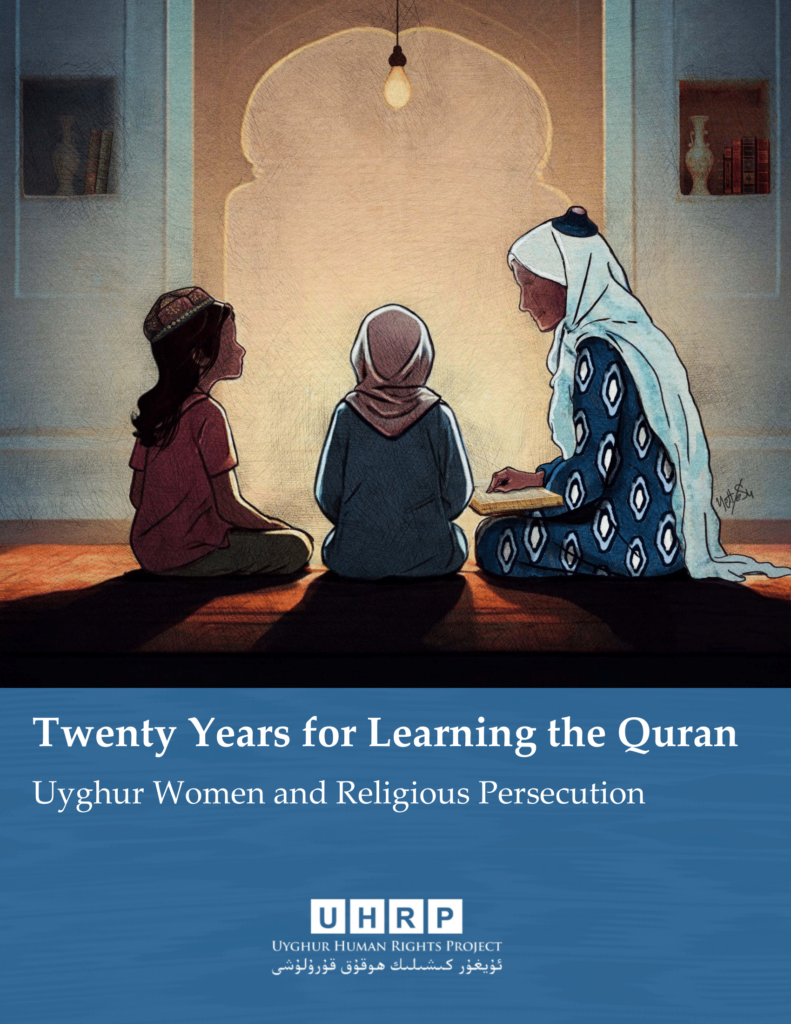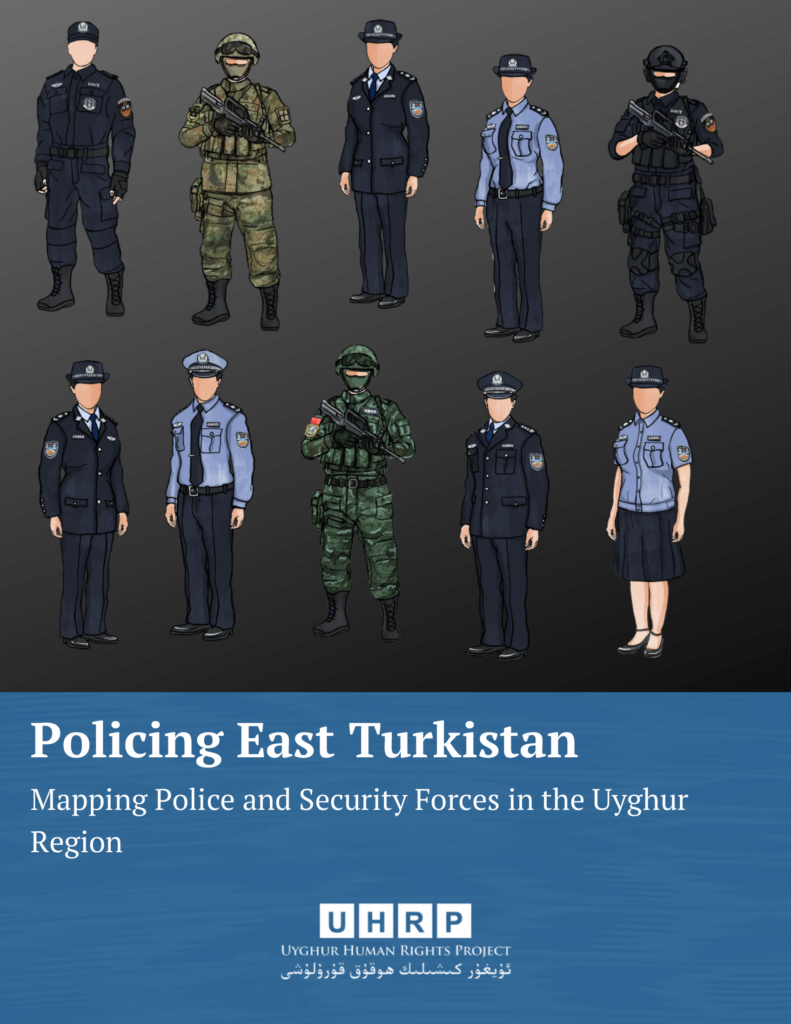A Uyghur Human Rights Project report by Nuzigum Setiwaldi. Read our press statement on the report here, and download the full report here.

I. Key Takeaways
- UHRP finds that 20 percent of red dates in the global supply chain are likely tainted by Uyghur forced labor.
- The Xinjiang Construction and Production Corps (XPCC) or “Bingtuan” holds a majority stake in at least 13 red date producing companies, which account for more than 25 percent of red date production in China. The XPCC, a major paramilitary and corporate organization, is responsible for carrying out mass internment, surveillance, and forced labor in East Turkistan.
- Between February and August 2022, local and online grocery stores in the Washington, DC metropolitan area stocked over 70 brands of red dates grown or processed in East Turkistan, including at least three with “Bingtuan” on their labels. Other products sourced from the Uyghur homeland, including raisins and walnuts, are also sold in U.S. grocery stores.
- Cotton is frequently intercropped with fruit, including red dates. In 2019, red dates accounted for 80% of fruit intercropped with cotton. Because cotton production is well documented as being at high risk of forced labor practices, fruit and fruit products, including red dates, should be considered at the same risk for forced labor as cotton.
- Since July 2020, all financial transactions with the XPCC have been prohibited for U.S. persons under Global Magnitsky Sanctions, and since January 2021, imports of XPCC cotton and tomato products to the U.S. have been a priority for enforcement of the U.S. ban on forced-labor imports. However, investigations have revealed that cotton and tomato products from the Region have continued to enter the U.S. market.
- As of June 21, 2022, all products from East have been targeted for priority enforcement of the U.S. ban on forced-labor imports, under the Uyghur Forced Labor Prevention Act (UFLPA). U.S. Customs and Border Protection (CBP) is mandated to detain all products sourced from the Uyghur Region on the presumption that they are the products of forced labor, unless the importer can demonstrate that the product supply chain is free of forced labor.
- UHRP’s research shows that U.S. food retailers and consumers risk complicity in forced labor and other atrocities, including genocide and crimes against humanity.

II. Investigation
Between February and August 2022, we investigated a dozen international grocery stores in the Washington, D.C. metropolitan area and identified red date products sourced from East Turkistan at seven stores. We also examined online international grocery stores that ship red date products from the Uyghur Region to the D.C. area. Using global and U.S. trade data from multiple sources, including UN ComTrade, Import Yeti, and Seamless Horizon, we traced red date products in global supply chains back to the Uyghur Region. We reviewed Chinese government reports, including the National Bureau of Statistics, China Statistical Yearbook, Xinjiang Statistical Yearbook, and XPCC Statistical Yearbook, in addition to records on Weixin (WeChat). We also reviewed U.S. government sanctions, including the UFLPA Entity List, to identify companies whose products are prohibited from importation into the U.S.
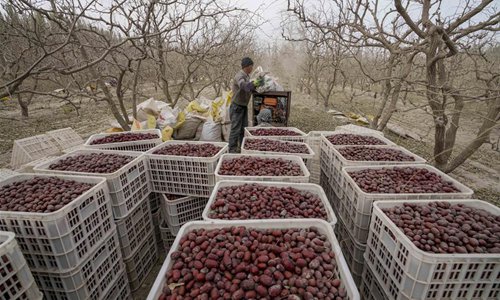
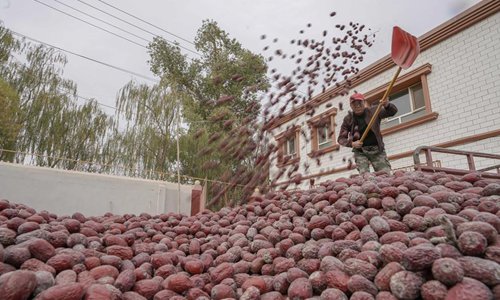
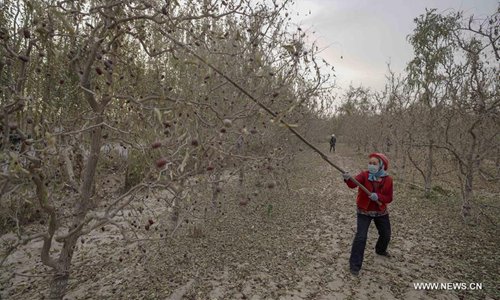
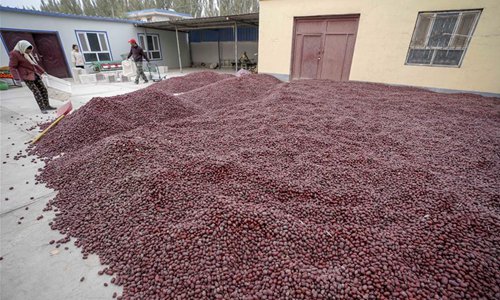
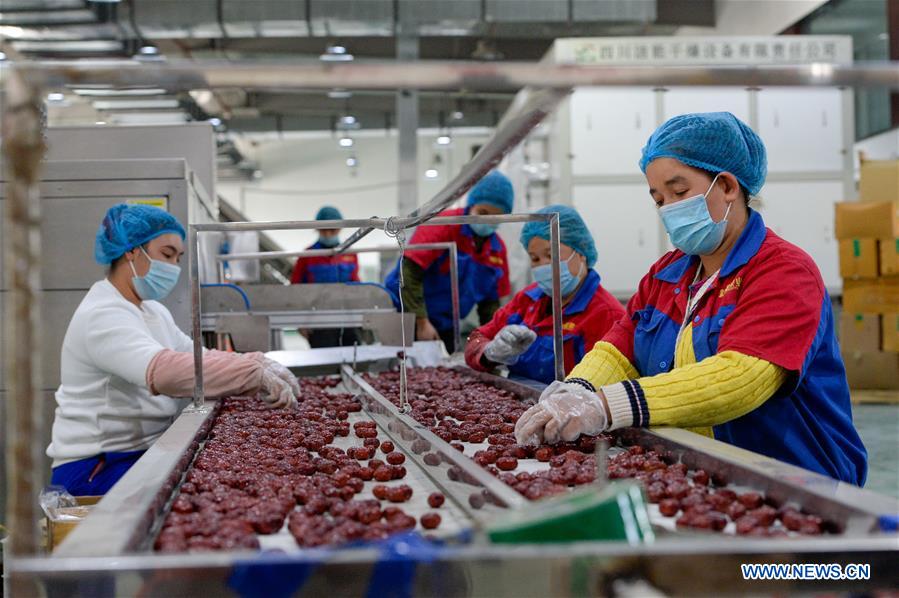
We contacted the grocery stores, distributors, and brands listed in this briefing with publicly available contact information. Several of the emails bounced back. Only a handful confirmed receipt of our correspondence but did not respond directly to our findings.

III. Findings
Red Date Industry in the Uyghur Region
China is the world’s top producer and exporter of red date products, producing 40 percent of the world’s output.1Shahrajabian, Mohamad Hesam, Wenli Sun, and Qi Cheng. “Chinese Jujube (Ziziphus Jujuba Mill.) – a Promising Fruit from Traditional Chinese Medicine”. Annales Universitatis Paedagogicae Cracoviensis Studia Naturae 5 (November 2020): 194–219, accessed August 5, 2022, https://doi.org/ 10.24917/25438832.5.13 Uyghur Region’s output accounted for exactly half of all China’s production, or 3.73 million tons of the national 7.46 million-ton total in 2019.2Liu, M., Wang, J., Wang, L. et al. “The historical and current research progress on jujube–a superfruit for the future,” Hortic Res 7, 119 (2020), accessed on August 5, 2022, https://doi.org/ 10.1038/s41438-020-00346-5 Overall, 20 percent of the world’s red dates come from the Uyghur Region and are likely the products of forced labor.
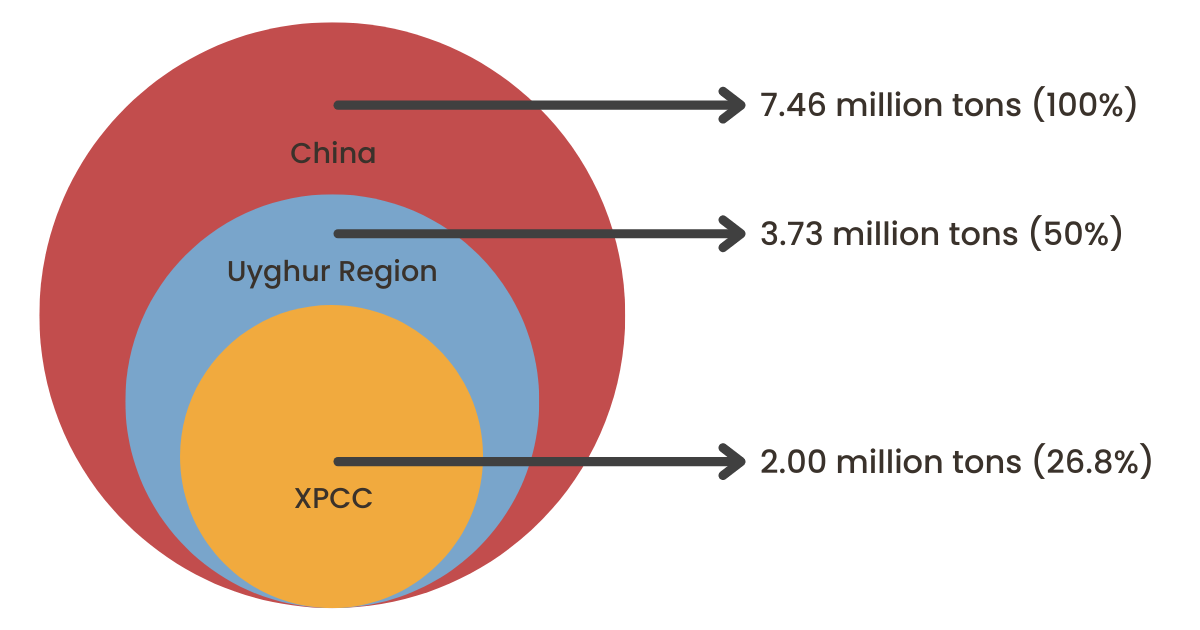
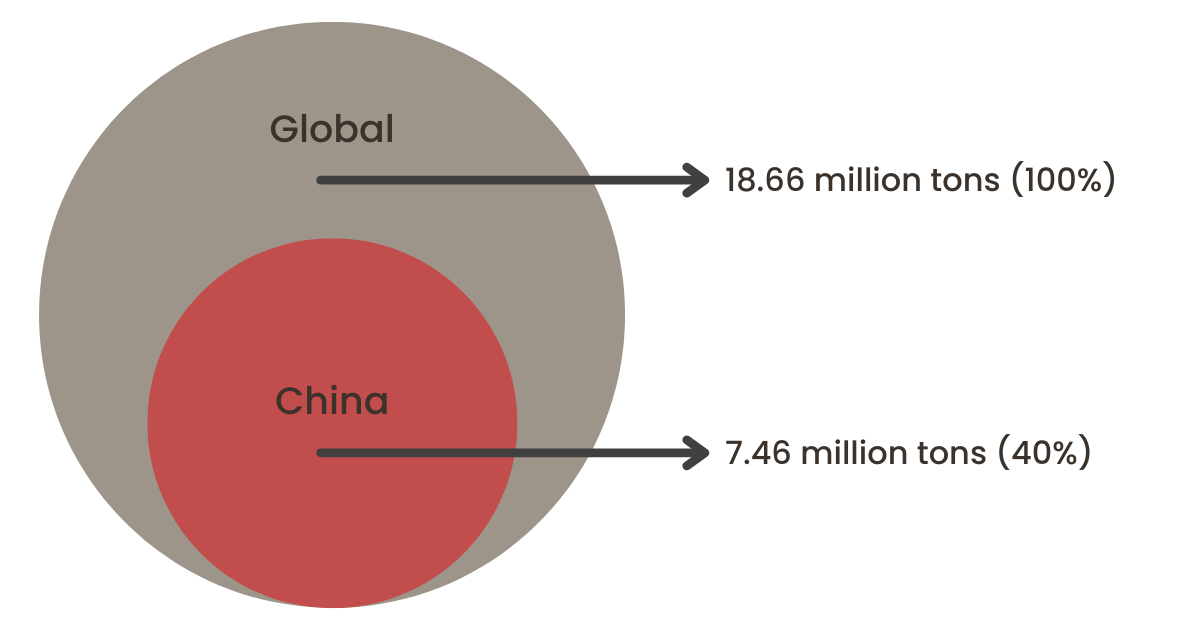
Red dates, also known as jujubes, are a small sweet fruit popular throughout Asia and beyond.3Shahrajabian, Mohamad Hesam, Wenli Sun, and Qi Cheng. “Chinese Jujube (Ziziphus Jujuba Mill.) – a Promising Fruit from Traditional Chinese Medicine”. Annales Universitatis Paedagogicae Cracoviensis Studia Naturae 5 (November 2020):194-219, accessed August 5, 2022, https://doi.org /10.24917/25438832.5.13; Liu, M., Wang, J., Wang, L. et al. “The historical and current research progress on jujube–a superfruit for the future,” Hortic Res 7, 119 (2020), accessed on August 5, 2022, https://doi.org/10.1038/s41438-020-00346-5 They are eaten fresh or dried and can also be processed into numerous forms including jams, teas, and paste. Red dates are promoted as a health food and are commonly used in traditional medicine in many Asian cultures.
Twenty percent of the world’s red dates come from the Uyghur Region and are likely the products of forced labor.
Red dates account for more than 20 percent of all fruits and nuts produced in East Turkistan, and are grown mainly in the south in places such as Kashgar, Aksu, Hotan, Qumul, and Turpan.4Bai Xiao, Na Kong, and Zhang Rong. “Research on the Transformation and Upgrading of Xinjiang Jujube Industry in the Context of ‘Silk Road Economic Belt’,” E3S Web Conf. Volume235, 2021, 2020 International Conference on New Energy Technology and Industrial Development (NETID 2020) (2021), accessed on August 5, 2022, https://doi.org/10.1051/e3scon f/202123502027 Red dates accounted for nearly half of all fruit produced by the XPCC in 2018 (followed by grapes, apples, pears, and walnuts).5“2020 Xinjiang Statistical Yearbook,” p. 385, China Statistics Press, 2019, https://www.sha hit.biz/yearbooks/2019%20Bingtuan%20Statistical%20Yearbook.pdf; 2019 XPCC Statistical Yearbook, p. 244–245, China Statistics Press, 2018, https://www.shahit.biz/yearbooks/20 19%20Bingtuan%20Statistical%20Yearbook.pdf Of the 3.73 million tons of red dates grown in the Uyghur Region in 2019, the XPCC produced 2 million tons (a quarter of the national total), with the remaining 1.73 million tons grown by various forms of smaller-scale producers.6“2020 Xinjiang Statistical Yearbook,” Tables 12-28, China Statistics Press, 2019, https://www.sha hit.biz/yearbooks/2019%20Bingtuan%20Statistical%20Yearbook.pdf Ten percent of the world’s red dates are directly tied to the XPCC and forced labor practices.
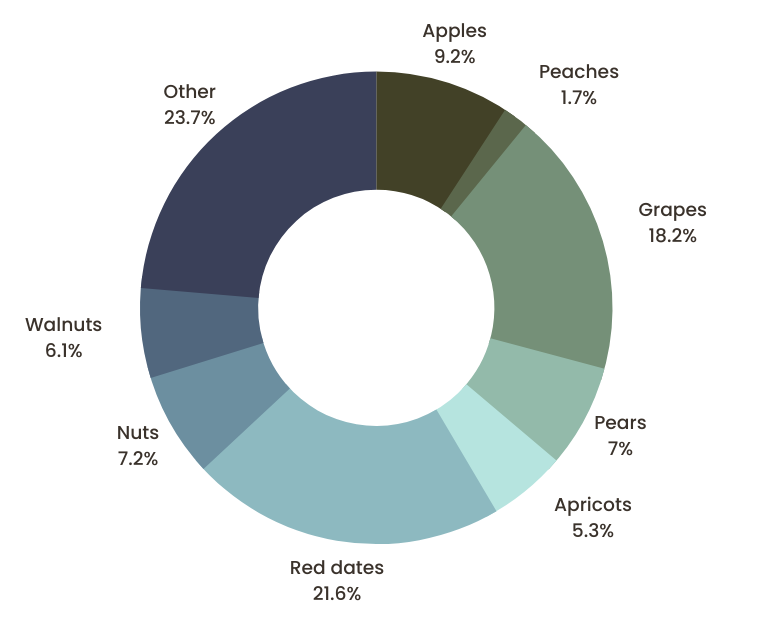
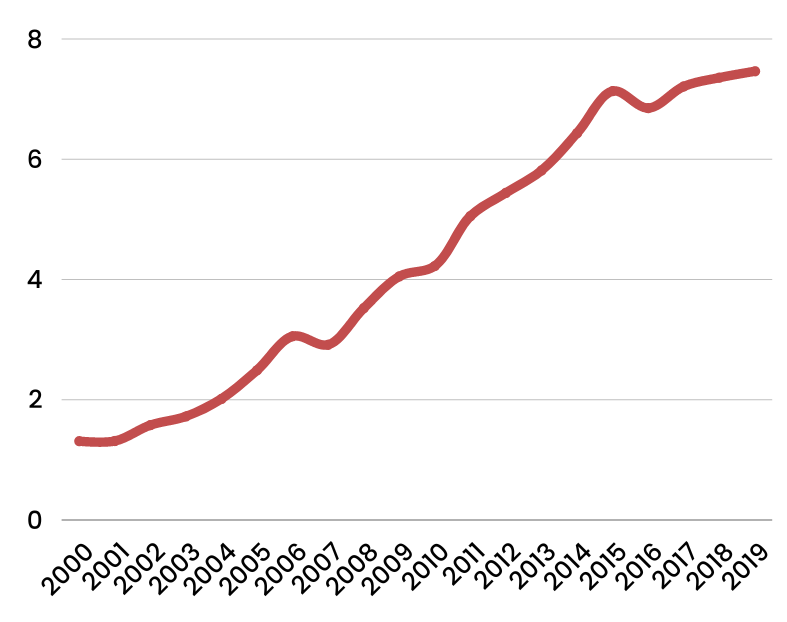
Red Dates Tied to Cotton Production
More than 80 percent of cotton produced in China, which constitutes 20 percent of the world’s cotton supply, comes from the Uyghur Region.7Laura T. Murphy, et al. “Laundering Cotton: How Xinjiang Cotton is Obscured in International Supply Chains,” Helena Kennedy Center for International Justice, Sheffield Hallam University, November 2021, accessed on August 5, 2022, https://www.shu.ac.uk/helena-kennedy-centre-international-justice/research-and-projects/all-projects/laundered-cotton One in five cotton apparel products and one in five red dates in the global supply chain could therefore be tainted with Uyghur forced labor.8Laura T. Murphy, et al. “Laundering Cotton: How Xinjiang Cotton is Obscured in International Supply Chains,” Helena Kennedy Center for International Justice, Sheffield Hallam University, November 2021, accessed on August 5, 2022, https://www.shu.ac.uk/helena-kennedy-centre-international-justice/research-and-projects/all-projects/laundered-cotton
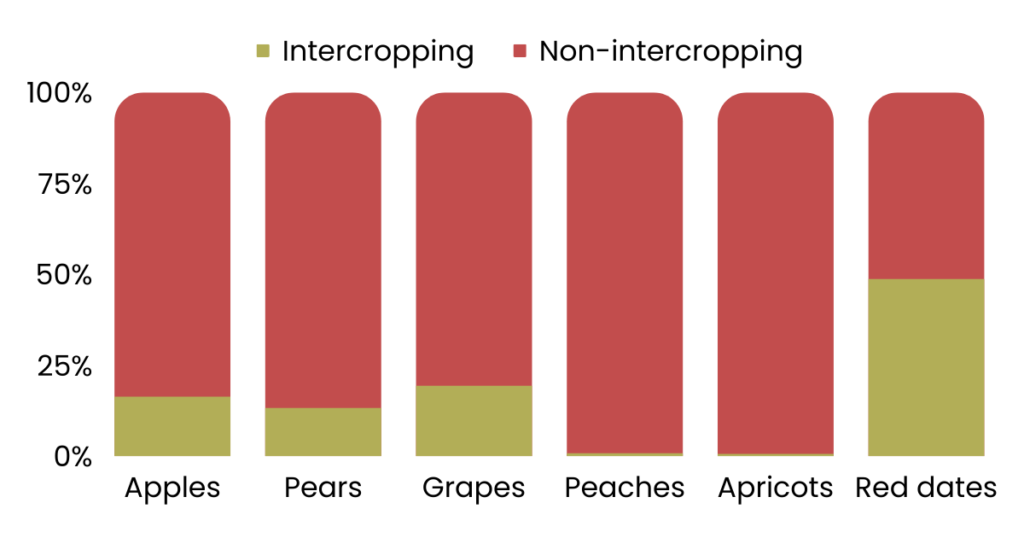
The red date industry in East Turkistan is directly linked to cotton production through the practice of intercropping, a method of agricultural production where two crops are grown simultaneously in the same field. Studies indicate that fruit-cotton intercropping is a common and efficient practice in the Uyghur Region.9XY Wang, T. Yang, and L. Shen, et al. “Formation of Factors Influencing Cotton Yield in Jujube-Cotton Intercropping Systems in Xinjiang, China,” Agroforest Syst 95, 177–189 (2021), accessed August 5, 2022, https://doi.org/10.1007/s10457-020-00571-w Planting red dates with cotton requires less water, improves crop quality, and yields a higher amount of both red dates and cotton, according to one study conducted in the region.10XY Wang, T. Yang, and L. Shen, et al., “Formation of Factors Influencing Cotton Yield in Jujube-Cotton Intercropping Systems in Xinjiang, China,” Agroforest Syst 95, 177–189 (2021), accessed August 5, 2022, https://doi.org/10.1007/s10457-020-00571-w According to XPCC data for 2018, red date-cotton intercropping is the primary form of fruit-cotton intercropping with nearly 80 percent (1.6 million tons) of red dates produced on cotton farms in 2019.11“2019 Xinjiang Production and Construction Corps Statistical Yearbook,” p. 264, China Statistics Press, 2018.
The direct link between red date and cotton production increases the likelihood that red date production is being tainted by Uyghur forced labor. Evidence clearly shows that cotton is produced using forced labor in East Turkistan with Uyghur detainees conscripted to pick raw cotton and to work in factories producing cotton-based yarn and fabric to manufacture apparel for international brands.12“Against Their Will: The Situation in Xinjiang,” Bureau of International Labor Affairs, U.S. Department of Labor, 2020, https://www.dol.gov/agencies/ilab/against-their-will-the-situation-in-xinjiang
State Forced Labor Policies
In 2018, the Chinese government invested 420 million yuan (US $63 million) in so-called “poverty alleviation” programs in East Turkistan, 80 percent of which went to XPCC concerns in southern East Turkistan.13“2019 Xinjiang Production and Construction Corps Statistical Yearbook,” p. 50, China Statistics Press, 2018, https://www.shahit.biz/yearbooks/2019%20Bingtuan%20Statistical%20Yearbook.pdf A key facet of “poverty alleviation” programs is transferring internees from detention camps, and forcing rural residents to work in state-managed and state-sponsored agricultural and industrial production.14Vicky Xiuzhong Xu, Danielle Cave, Dr James Leibold, Kelsey Munro, and Nathan Ruser. “Uyghurs for sale: ‘Re-education’, forced labor and surveillance beyond Xinjiang,” Australian Strategic Policy Institute and the International Cyber Policy Center, 2020, p. 3, accessed on August 5, 2022, https://www.aspi.org.au/report/uyghurs-sale
The direct link between red date and cotton production increases the likelihood that red date production is being tainted by Uyghur forced labor.
Between 2017 and 2019, the Chinese government transferred an estimated 80,000 Uyghurs from detention camps to work in factories in mainland China as part of those poverty alleviation programs.15Vicky Xiuzhong Xu, Danielle Cave, Dr James Leibold, Kelsey Munro, and Nathan Ruser. “Uyghurs for sale: ‘Re-education’, forced labor and surveillance beyond Xinjiang,” Australian Strategic Policy Institute and the International Cyber Policy Center, 2020, p. 3, accessed on August 5, 2022, https://www.aspi.org.au/report/uyghurs-sale Under the government “rural surplus labor” transfer program, 2.87 million people were transferred within the region and to mainland China each year between 2016 to 2020 and 3.2 million were transferred in 2021.16Adrian Zenz. “Unemployment Monitoring and Early Warning: New Trends in Xinjiang’s Coercive Labor Placement Systems,” Victims of Communism Memorial Foundations, June 5, 2022, accessed August 5, 2022, https://victimsofcommunism.org/publication/unemployment-monitoring-and-early-warning
Chinese state media promotes red dates, walnuts, and raisins as “poverty relief products,”17Fighting Poverty in Xinjiang: E-commerce development boosts farm produce sales,” China Global Television Network (CGTN), May 6, 2020, https://news.cgtn.com/news/30637a4d795 14464776c6d636a4e6e62684a4856/index.html and the XPCC claims red date production has significantly increased farmers’ incomes and reduced poverty in the south.18“Power of the youth helps Xinjiang alleviate poverty,” CGTN, April 30, 2020, https://ne ws.cgtn.com/news/2020-04-29/Power-of-the-youth-helps-Xinjiang-alleviate-poverty-Q3Cb7M1kxq/index.html; “Red jujubes bring wealthy lives to farmers in China’s Xinjiang,” New Xinhua TV, December 2, 2019, https://www.youtube.com/watch?v=M4ZJuMEJh-k However, researchers and human rights monitors report China’s economic development and poverty alleviation programs are directly linked to XPCC mass detention and surveillance campaigns.19Vicky Xiuzhong Xu, Danielle Cave, Dr James Leibold, Kelsey Munro, and Nathan Ruser. “Uyghurs for sale: ‘Re-education’, forced labour and surveillance beyond Xinjiang,” Australian Strategic Policy Institute and the International Cyber Policy Centre, 2020, accessed on August 5, 2022, https://www.aspi.org.au/report/uyghurs-sale; Laura Murphy, Nyrola Elima, and David Tobin. “Until Nothing is Left: China’s Settler Corporation and its Human Rights Violations in the Uyghur Region,” Helena Kenned Centre for International Justice, Hallam University, July 2022, accessed on August 5, 2022, https://www.shu.ac.uk/helena-kennedy-centre-international-justice/research-and-projects/all-projects/until-nothing-is-left
[R]esearchers and human rights monitors report China’s economic development and poverty alleviation programs are directly linked to XPCC mass detention and surveillance campaigns.
Furthermore, XPCC farms and factories are directly tied to state-sponsored land expropriation in East Turkistan. Originally formed as a branch of the Chinese military in 1954, the XPCC was tasked with establishing farms, ranches, and factories across the Uyghur Region.20“The History and Development of the Xinjiang Production and Construction Corps (full text),” State Council of the People’s Republic of China, October 5, 2014, http://english.www.gov.cn/ archive/white_paper/2014/10/05/content_281474992384669.htm Land reclamation projects have displaced Uyghurs who were forced to give up their land for XPCC operations.21“Farmers Vow to Pressure Beijing,” Radio Free Asia, November 9, 2010, https://www.rfa.org/ english/news/uyghur/farmers-11092010152433.html XPCC settlements have significantly expanded, particularly in the south, as Han Chinese migrants have taken advantage of government incentives to relocate and work on agriculture and infrastructure projects founded on land that had been held by Uyghur communities for generations, while XPCC projects have redirected sources of water away from local Uyghur farmers.22Gao Feng, “China tightens grip on activists, dissidents ahead of Tiananmen massacre anniversary,” Radio Free Asia, May 31, 2022, https://www.rfa.org/english/news/china/tian anmen-anniversary-05312022124339.html These practices have placed Uyghur farmers, including traditional red date farmers, at a high risk of employment discrimination and forced labor.23Gao Feng, “China tightens grip on activists, dissidents ahead of Tiananmen massacre anniversary,” Radio Free Asia, May 31, 2022, https://www.rfa.org/english/news/china/tian anmen-anniversary-05312022124339.html
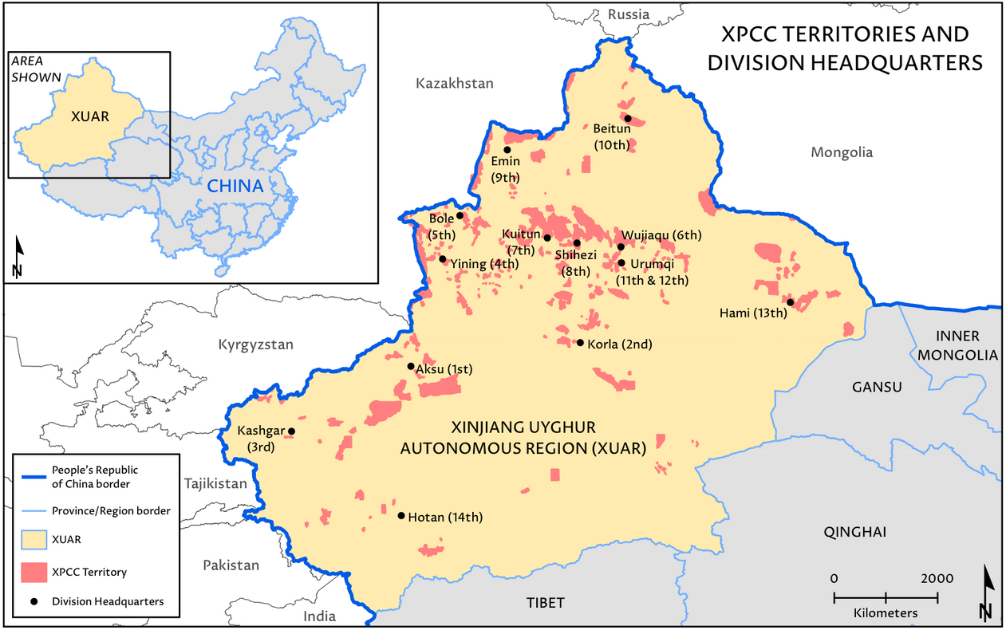
Ties to Global Supply Chains
The XPCC has partial or full ownership of 862,000 companies globally. It owns more than 50 percent of nearly 3,000 of those companies, including at least 13 red date producing companies.24Irina Bukharin, “Long Shadows: How the Global Economy Supports Oppression in Xinjiang,” C4ADS, August 2021, https://c4ads.org/long-shadows XPCC data for 2018 shows 1.3 million tons of fruits were produced on XPCC farms, including 570,000 tons of red dates at so-called “needy and border farms” in the southern part of the Uyghur Region.252019 Xinjiang Production and Construction Corps Statistical Yearbook,” p. 264, China Statistics Press, 2020, https://www.shahit.biz/yearbooks/2019%20Bingtuan%20Statistical%20Yearbook.pdf Over 543,000 tons of fruits, including 223,000 tons of red dates, were produced at so-called “minority farms.” The XPCC publishes production numbers for various types of farms, including center farms, small town farms, cotton-planting farms, border farms, needy farms, and minority farms.26“2019 Xinjiang Production and Construction Corps Statistical Yearbook,” tables 9-39, p. 264, China Statistics Press, 2020, https://www.shahit.biz/yearbooks/2019%20Bingtuan%20Statist ical%20Yearbook.pdf At least one in five red dates in the global market are produced either by the XPCC or in the Uyghur Region where gross human rights violations against minoritized citizens, including forced labor, are pervasive.
Red Dates in U.S. Markets
Today, at least 20 percent of red dates in the world are directly or indirectly linked to the XPCC’s and forced labor practices. Red dates sourced from other producers in the Uyghur Region are also at high risk of being tainted by forced labor, and those produced in mainland China may also be linked to forced labor by labor transfer programs out of the Uyghur Region.
At least one in five red dates in the global market are produced either by the XPCC or in the Uyghur Region where gross human rights violations against minoritized citizens, including forced labor, are pervasive.
According to U.S. trade data, Chinese companies made 164 shipments of red date products from the Uyghur Region and mainland China to the U.S. from 2017 to 2022.27C4ADS, (HS codes 2006.00, 081090, 081340, and 080590). Of those shipments, 100 were made prior to the July 2020 sanctions on the XPCC and 64 shipments were made after. Many of these red date products referenced “Xinjiang” or Uyghur cities in the goods descriptions. These continued shipments suggest multiple sanctions against the XPCC are not stopping red dates produced in East Turkistan from reaching grocery shelves in the U.S., even despite the fact that at least three brands, Bingtuan Mingzhu and Bingtuan Hong, and Red Corps actually have the word “Bingtuan” on their packaging.


Local grocery stores in the Washington, D.C. area and online retailers that ship to D.C. stock over 70 different brands of red date products from China, including Bingtuan Mingzhu, Bingtuan Hong, Farmer Brand, Gather Red, Growland, Sihong, and Zhishein. At least seven Asian and international grocery stores in the D.C. area – Fresh World, Great Wall Supermarket, Good Fortune Supermarket, H Mart, Lotte Plaza Market, LA Mart, and 99 Ranch Market – collectively stock more than 50 types of red date products produced in East Turkistan. A number of online retailers including Yami, Sayweee!, Unami Cart, Just Asian Food, and Fresh Go Go, also ship red date products from the Uyghur Region to the U.S. in addition to their retail activities.
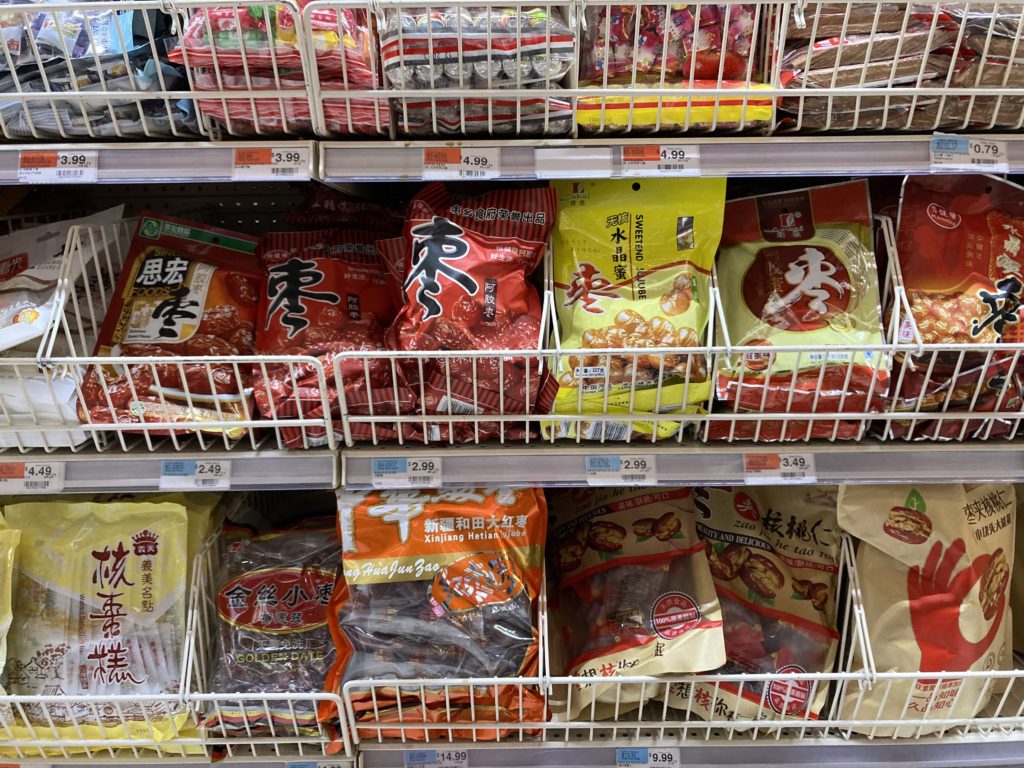
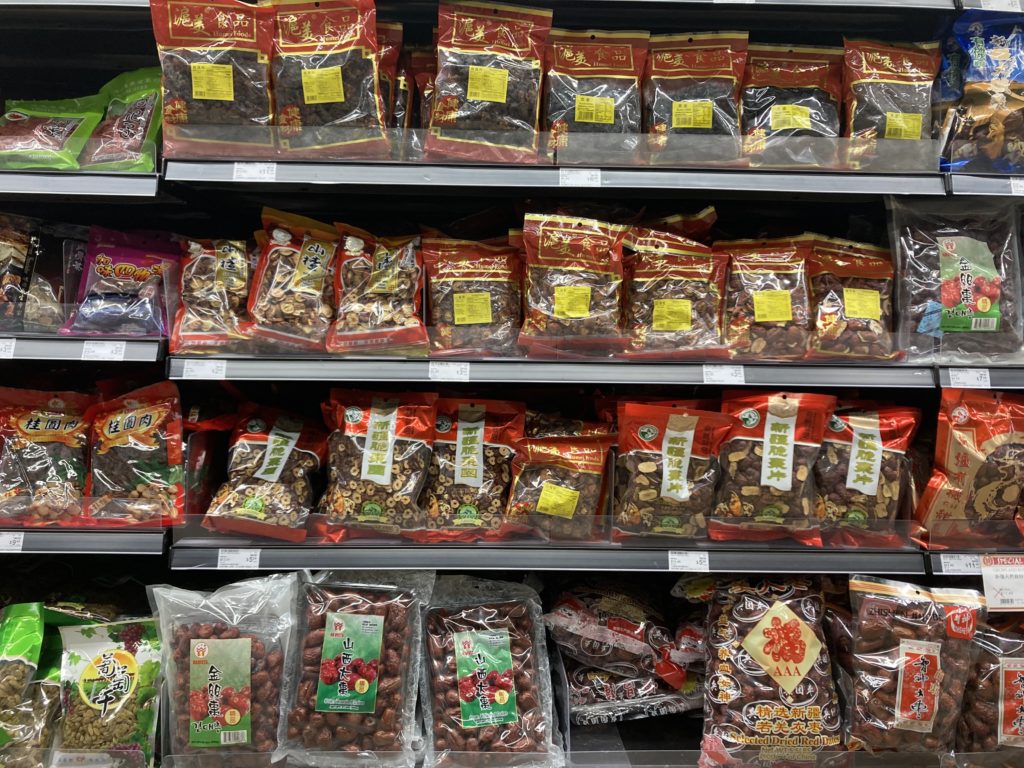
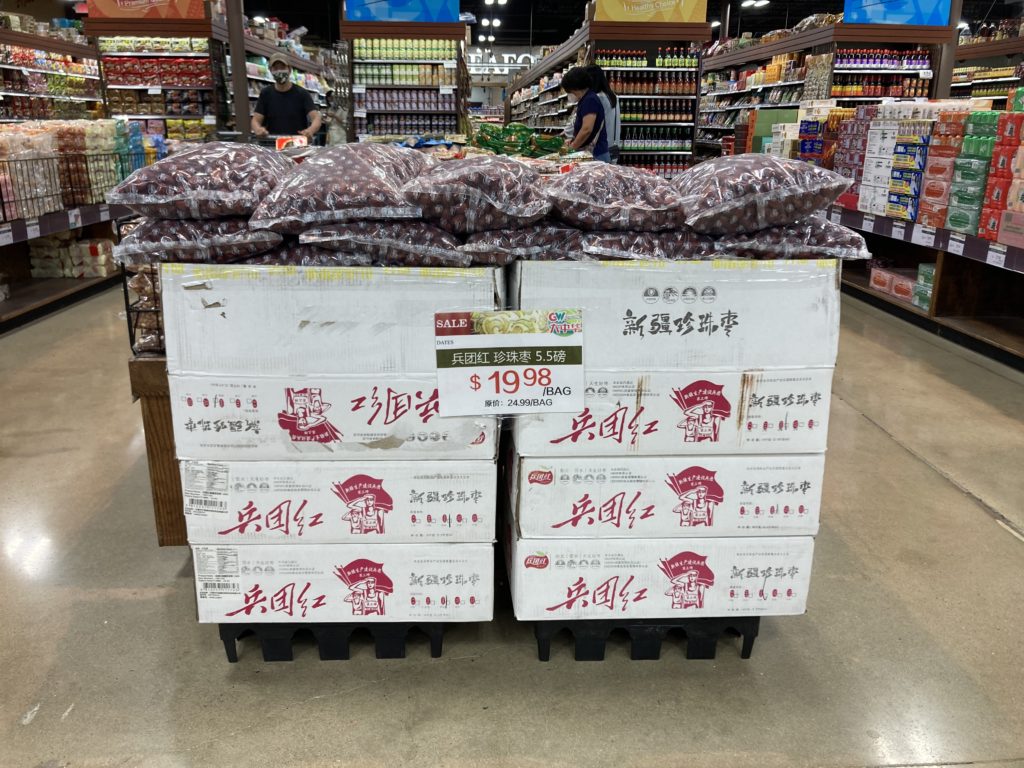
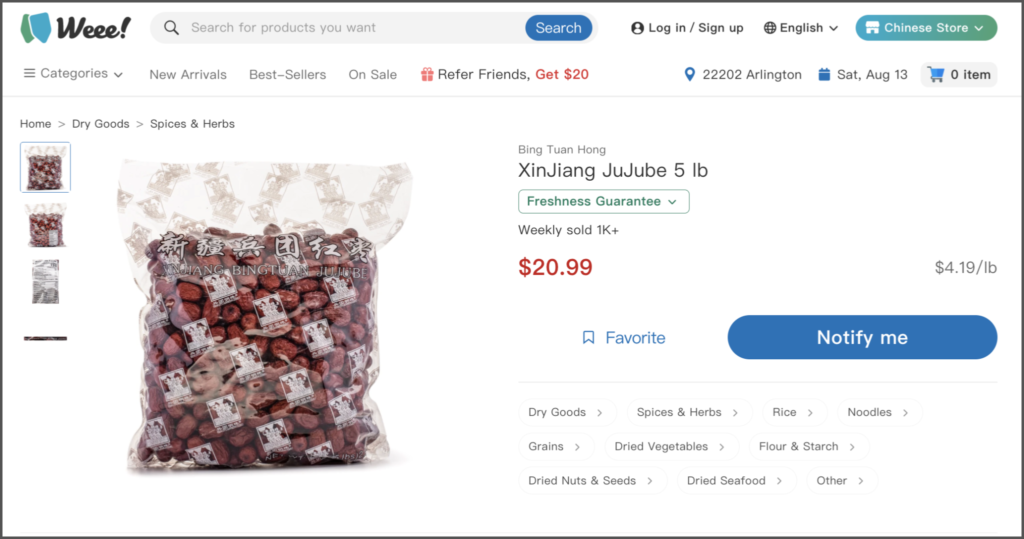
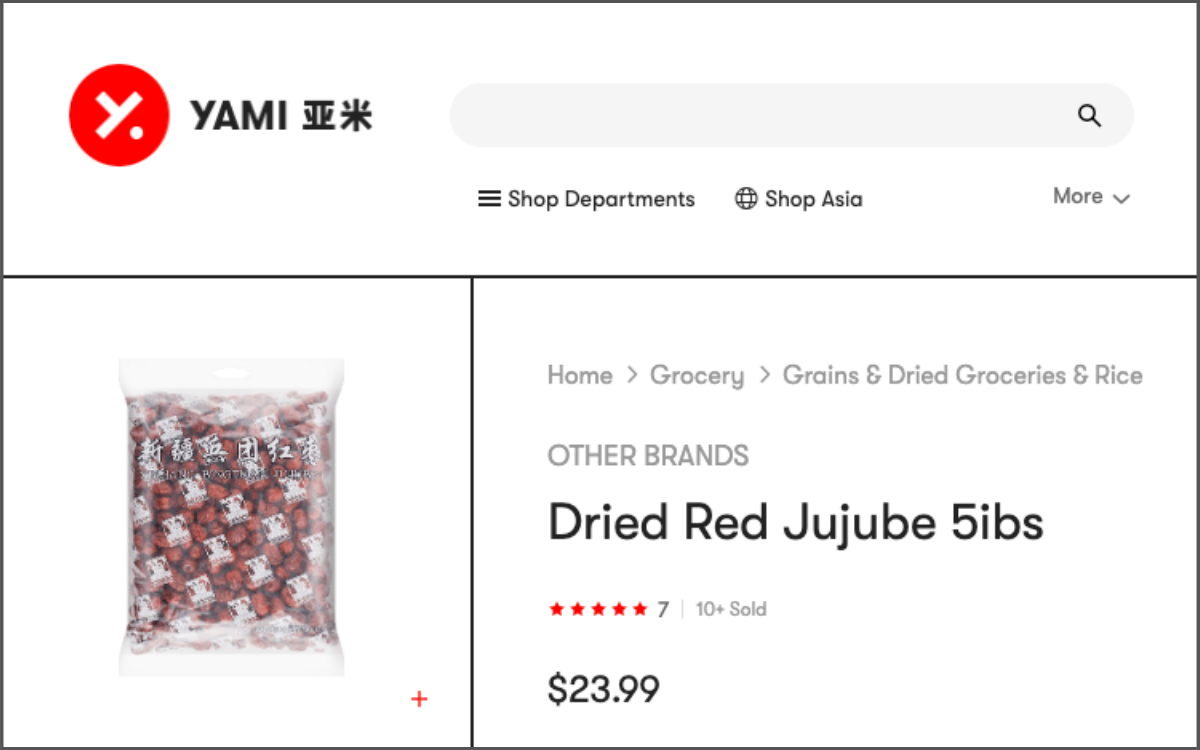
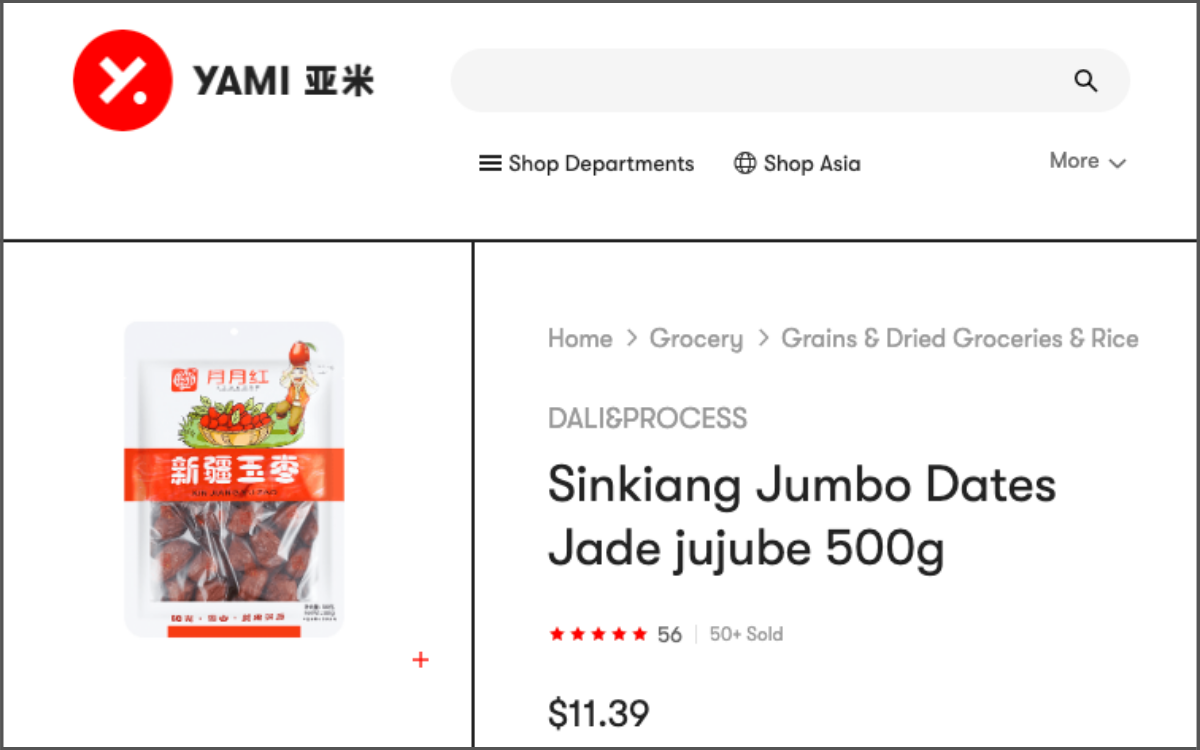
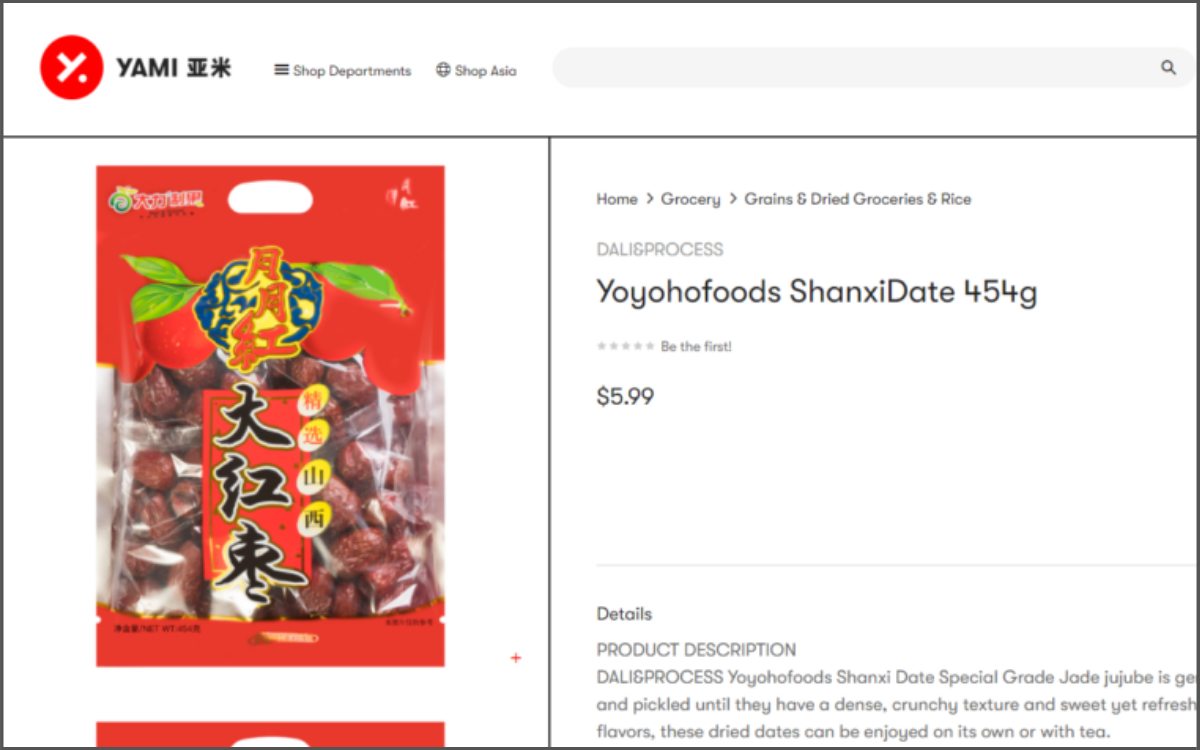
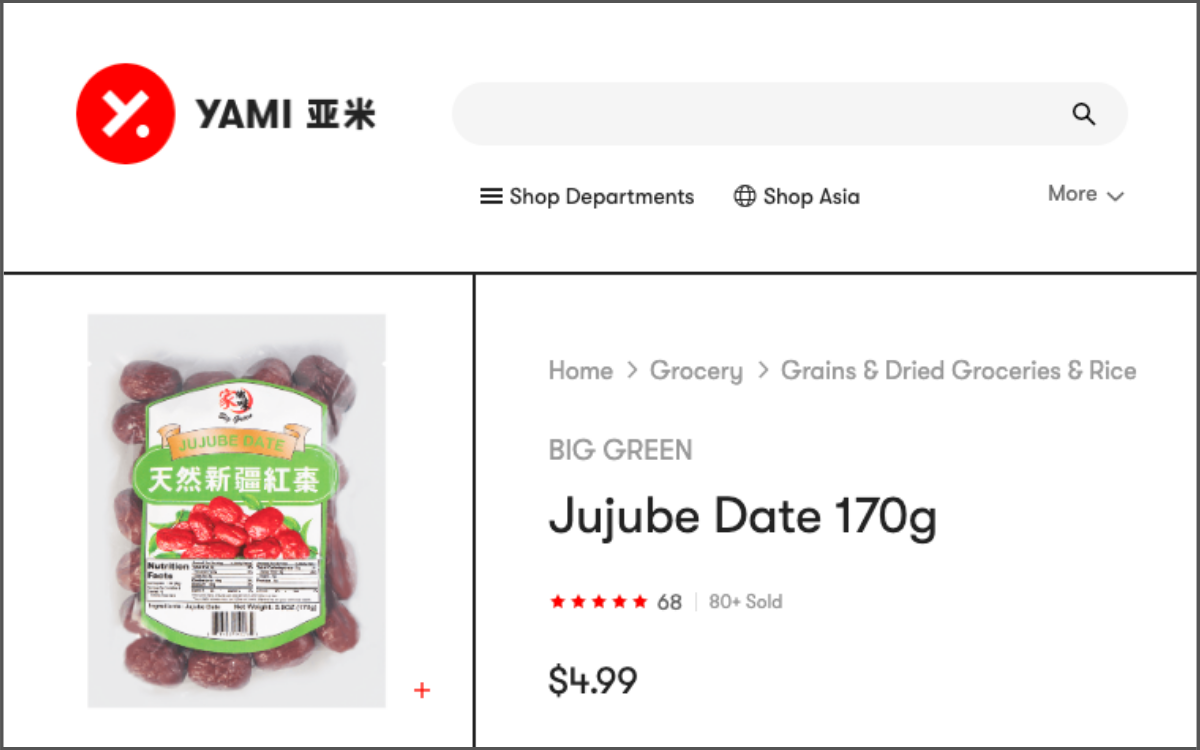
U.S. online marketplaces including Amazon, Ebay, and Walmart, sell red dates from the Uyghur Region. A number of brands and wholesalers, including Growland, Big Green USA, EAPC, and Nest Lady, also list red date products from the Uyghur Region on their websites.28See, for example: Growland Shop, https://growland.shop; Big Green USA, https://biggreenusainc.com/; EAPC, https://eapcusa.com; Nest Lady, https://nestladyAt least 15 U.S. companies import red date products for wholesale distribution to retailers, including Bloomington Import, Growland Inc., H&C Food Inc., OCM Globe Inc., and Tristar Food Wholesale Co., Inc.
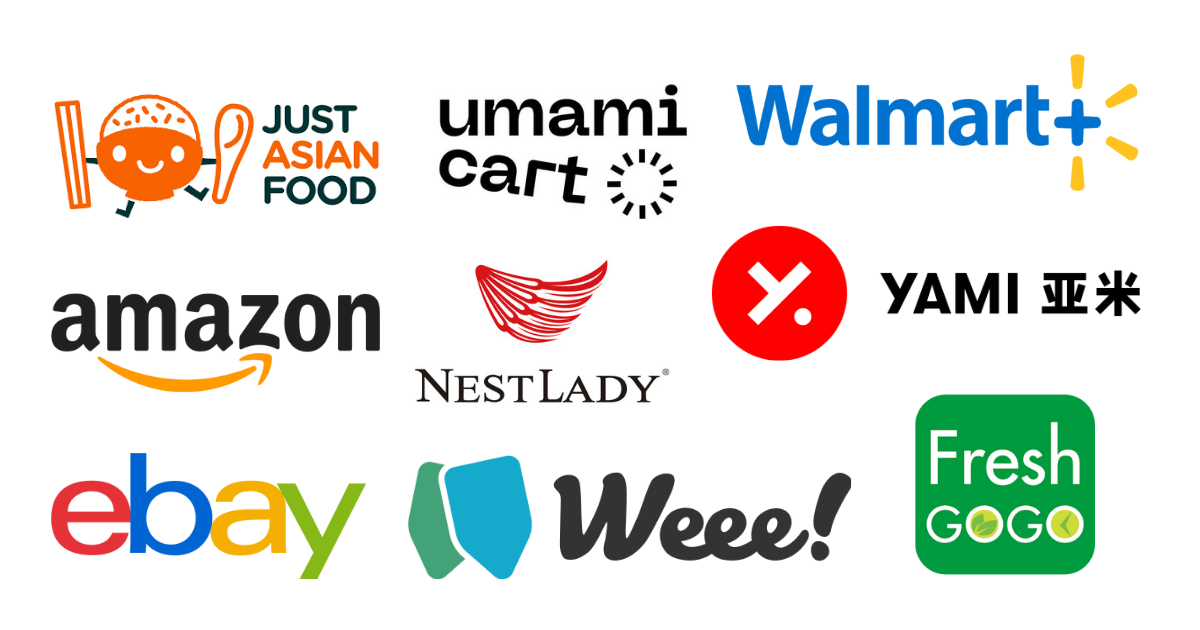
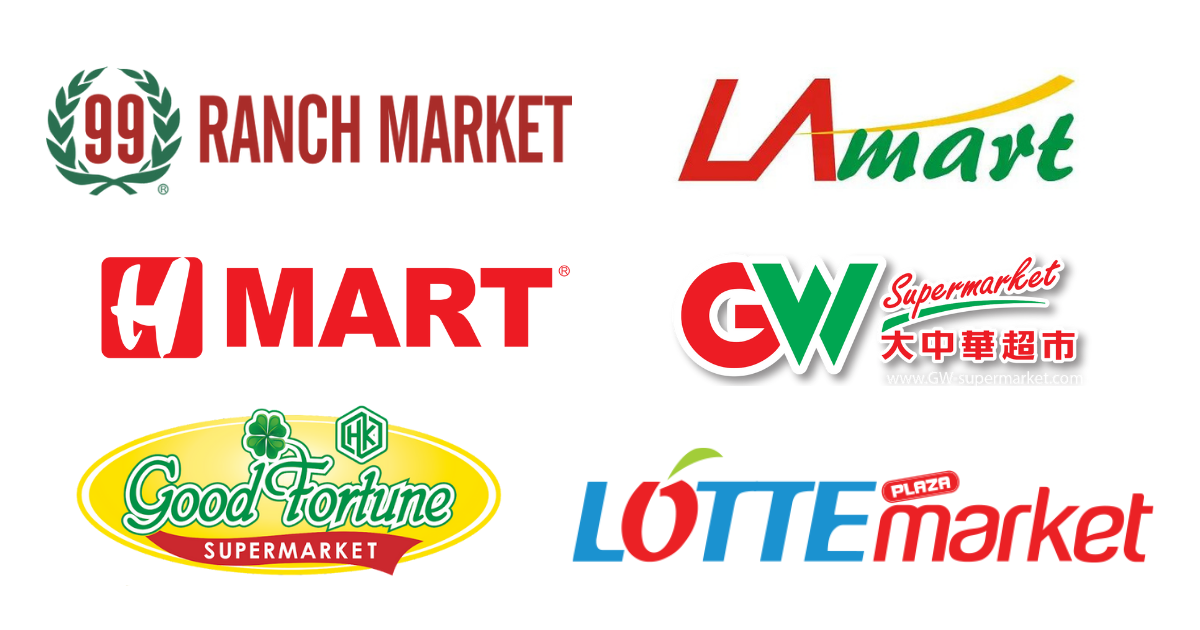
The majority of red date product labels list China as the country of origin. Uyghur Region red date products that have been transshipped or processed in other countries were not included in UHRP’s investigation due to traceability limitations. Many of the red date products from China sold online reference “Xinjiang” either on the label or in the product description, or both. Labels specifying the type of red dates often refer to cities in the Uyghur Region including Hotan, Kargilik, Aqsu, and Qumul.
A number of red date brands market their products by appropriating Uyghur cultural symbols or stereotypical images linked to the Uyghur homeland. All Growland red date products feature drawings of Uyghur musicians and dancers from Ghazi Ahmet’s famous painting “Meshrep” next to an outline of a mosque and mountains. Farmer Brand products also include drawings of a Uyghur dancer and drummer alongside a caravan of camels in the Taklamakan Desert. Dali & Process Xinjiang Jade Jujube packaging depicts a boy in Uyghur traditional clothes carrying a giant red date.
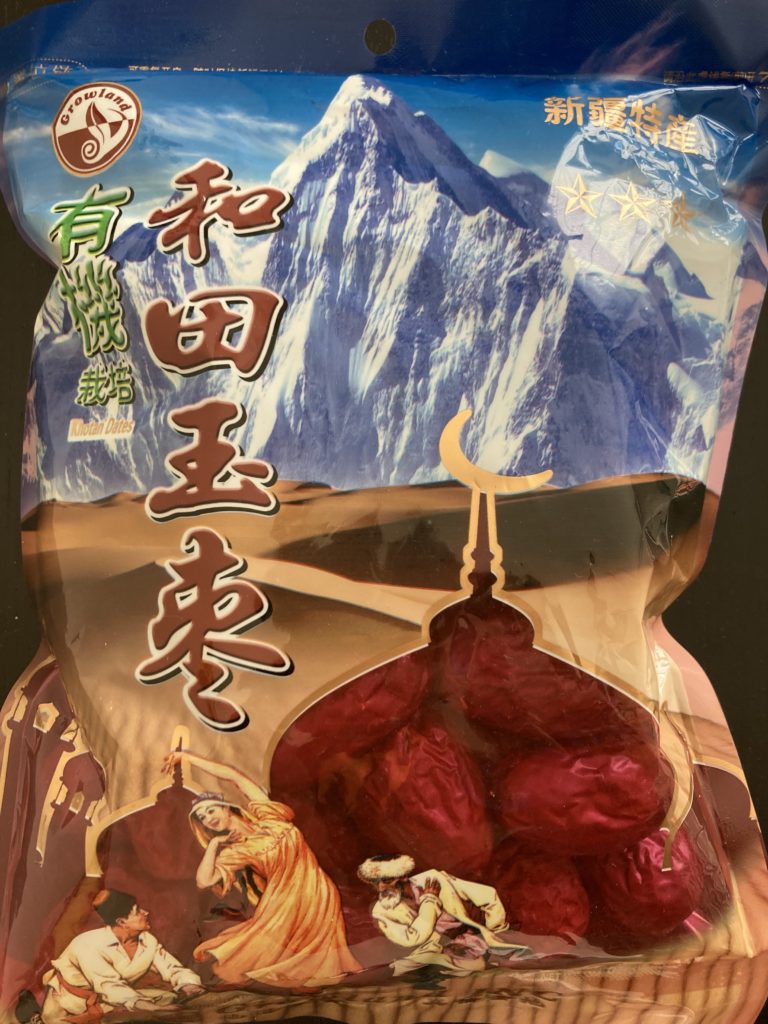
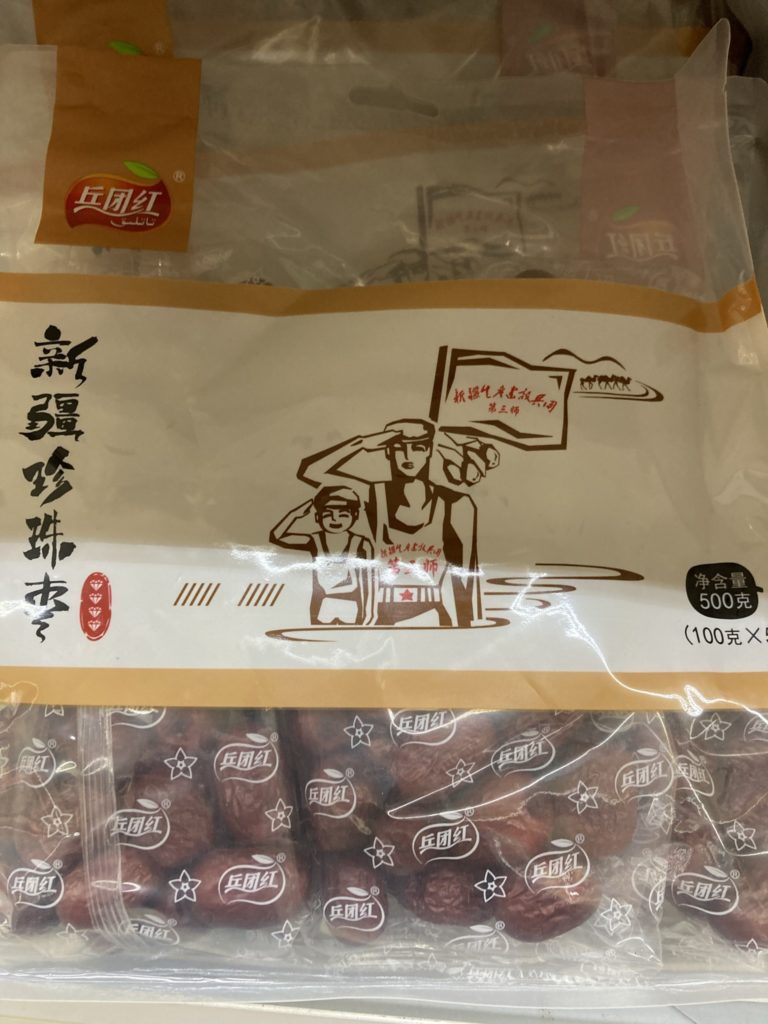
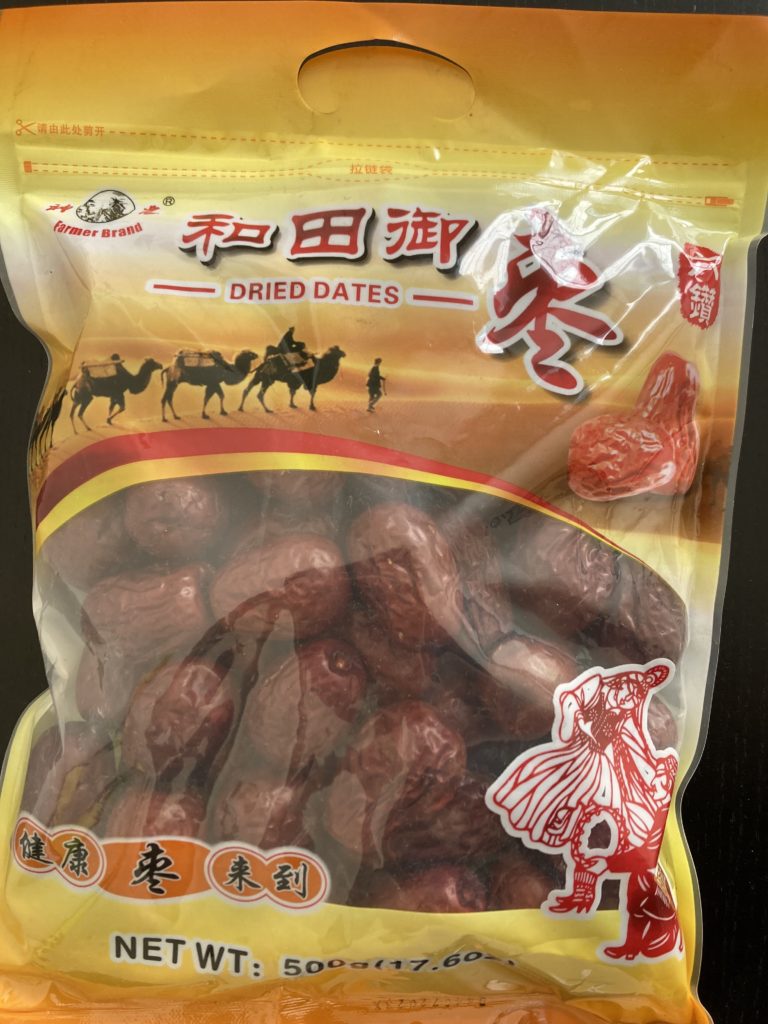
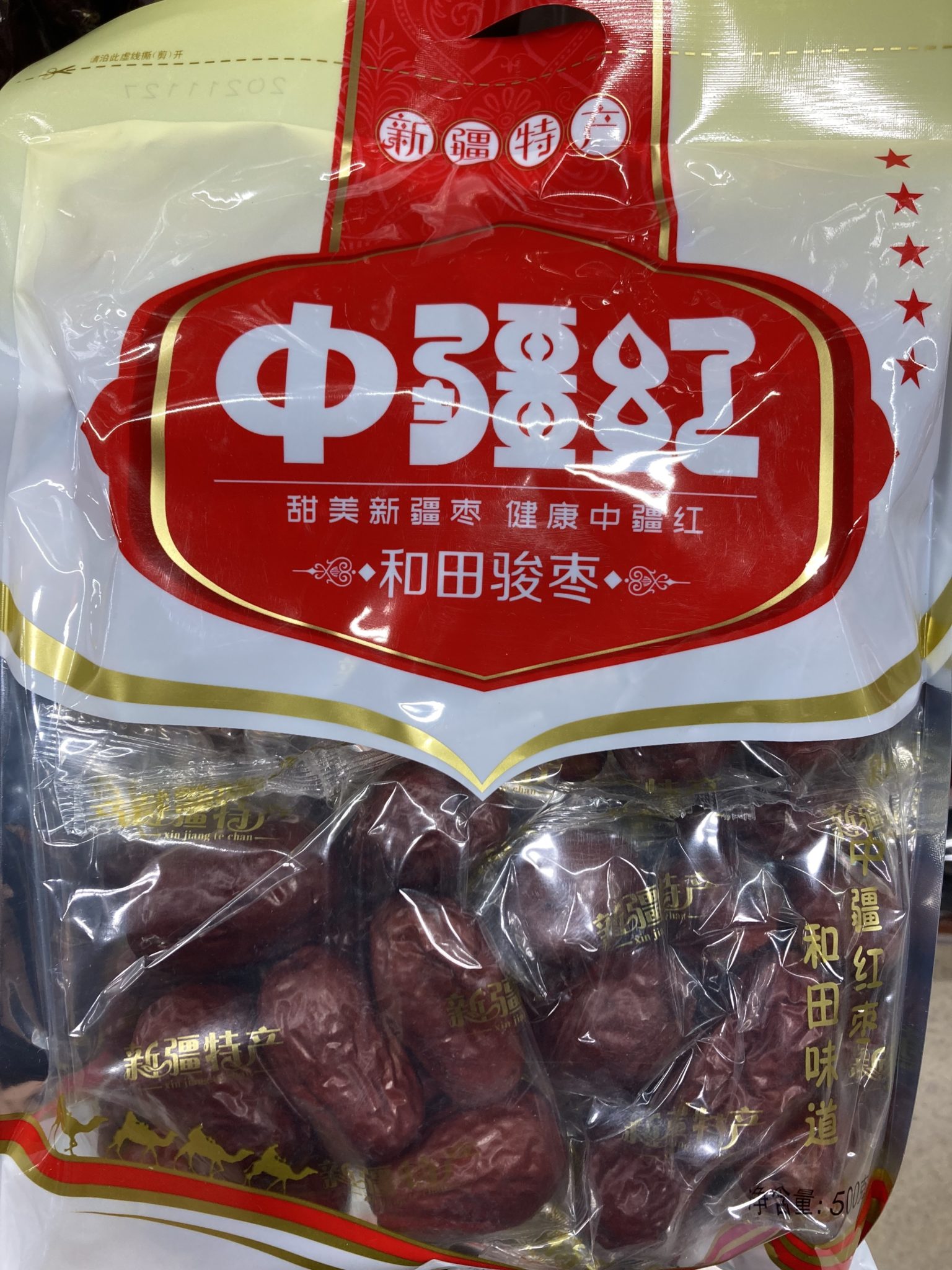
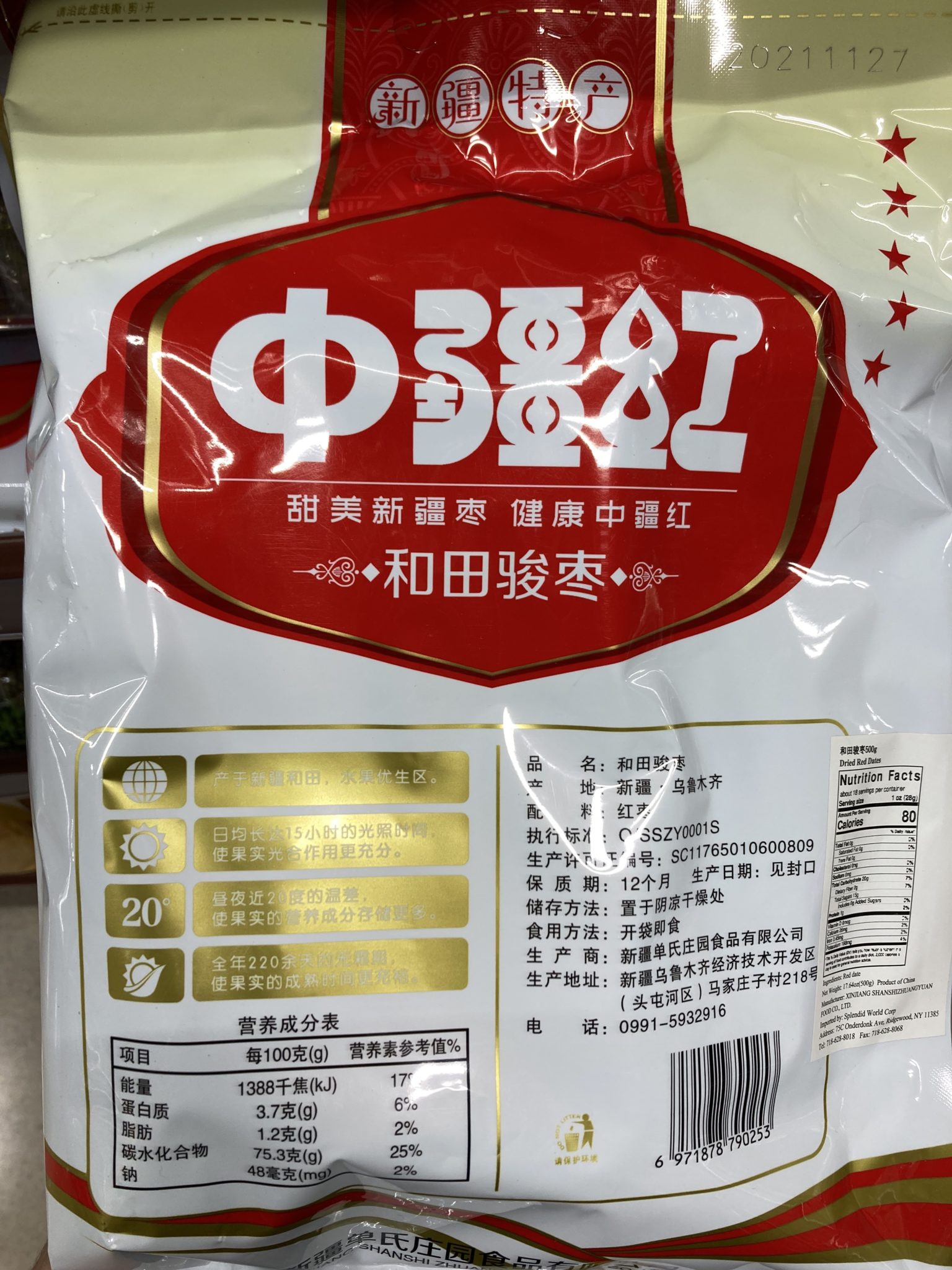
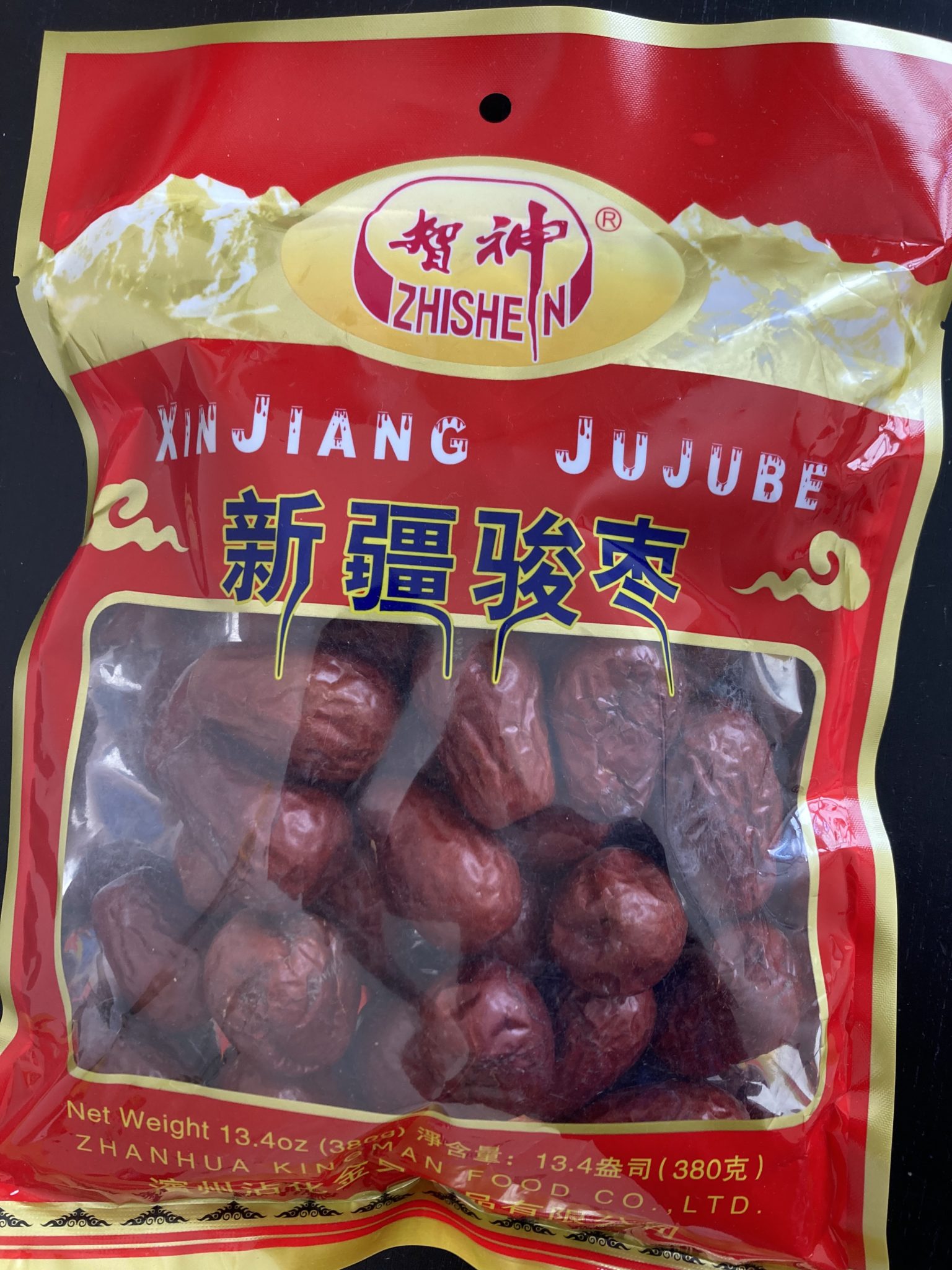
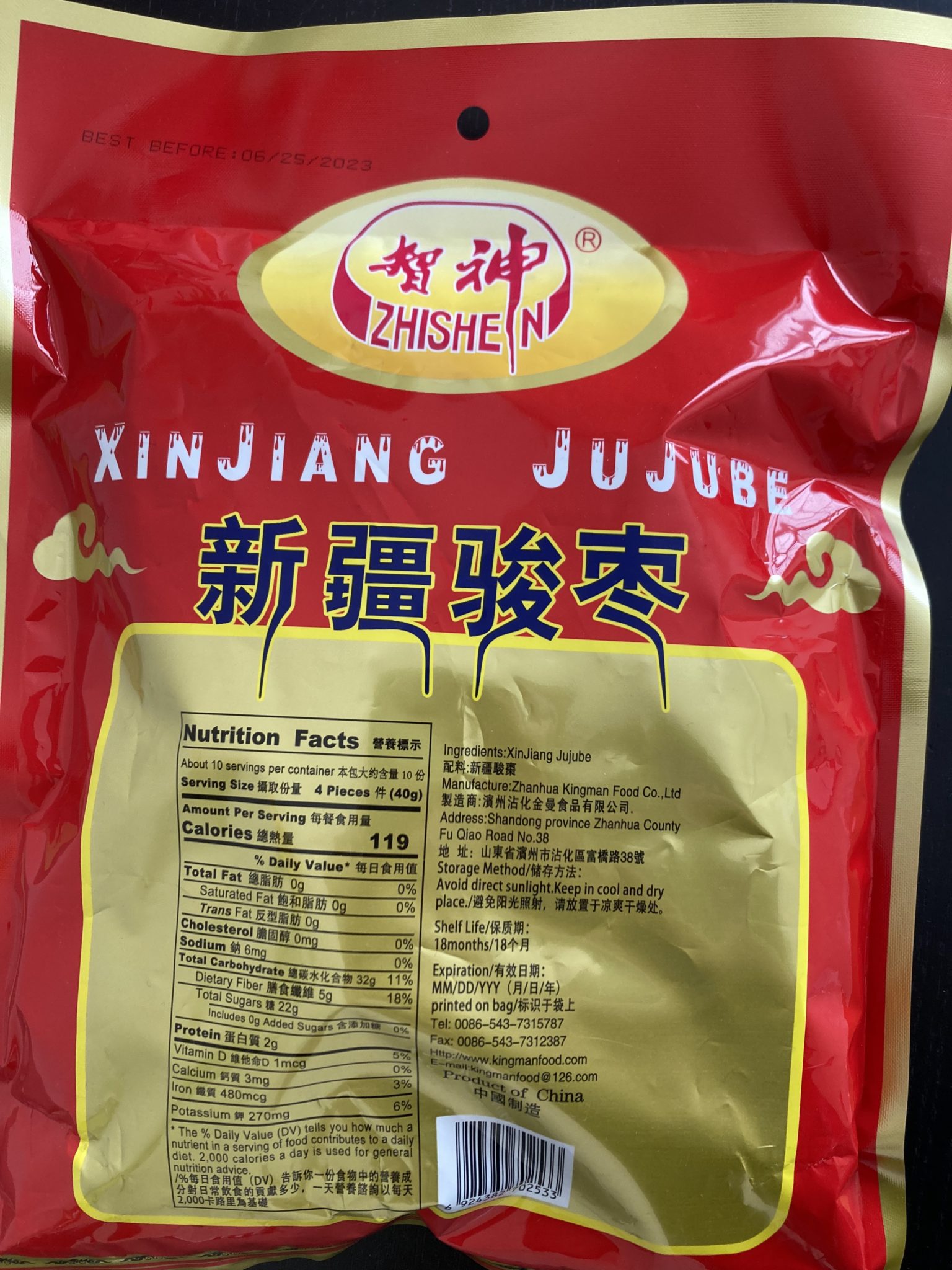
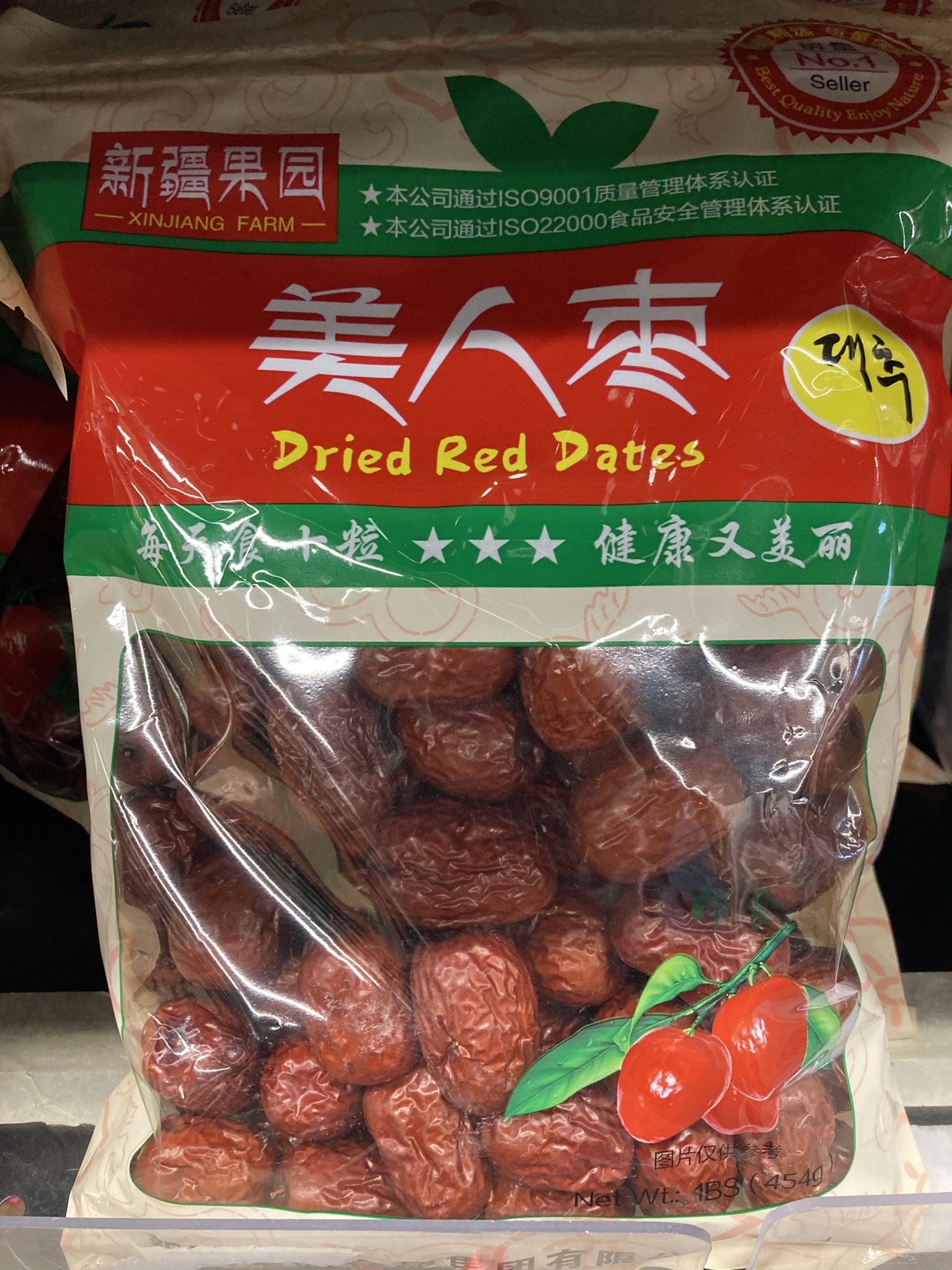
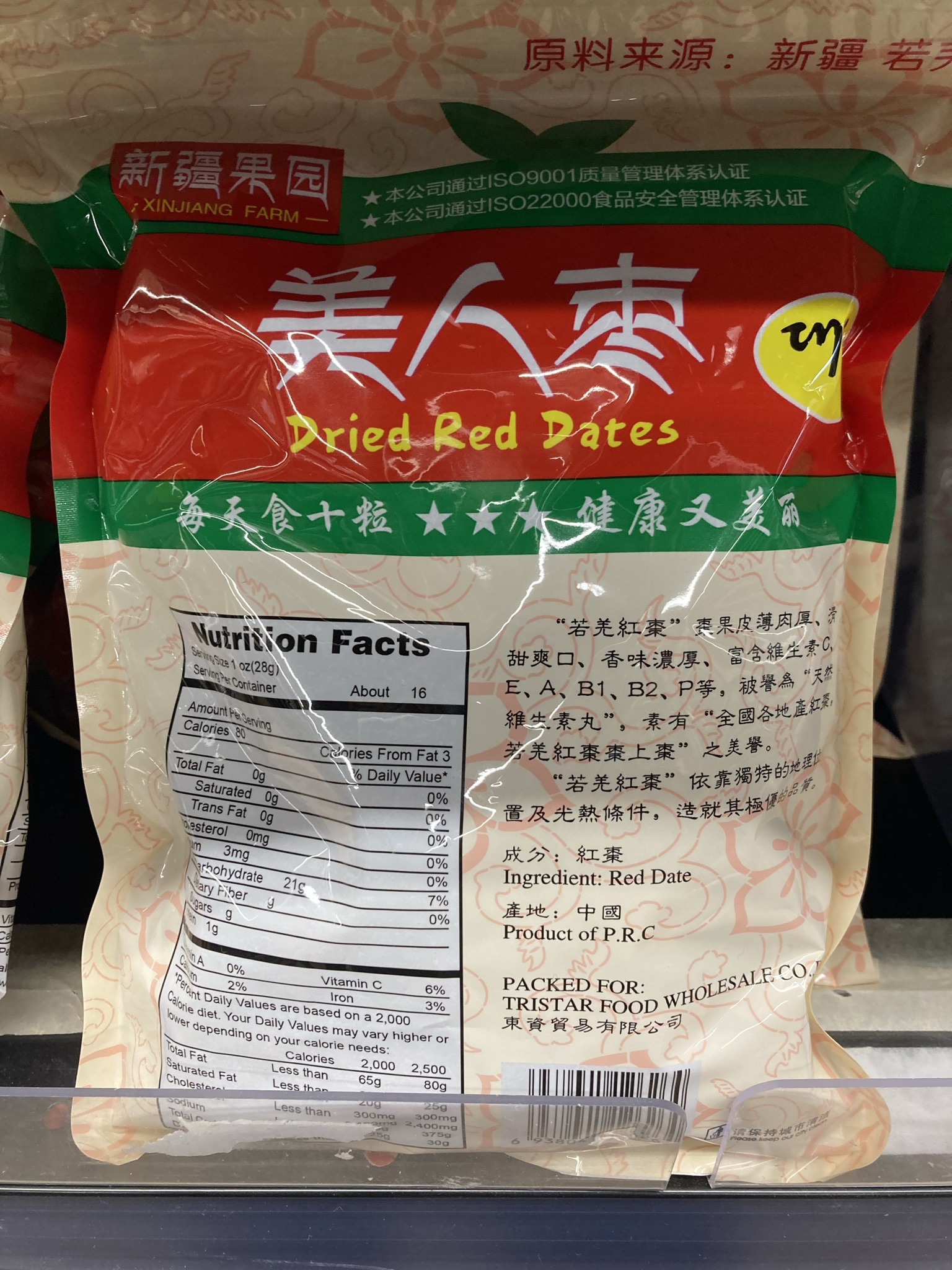
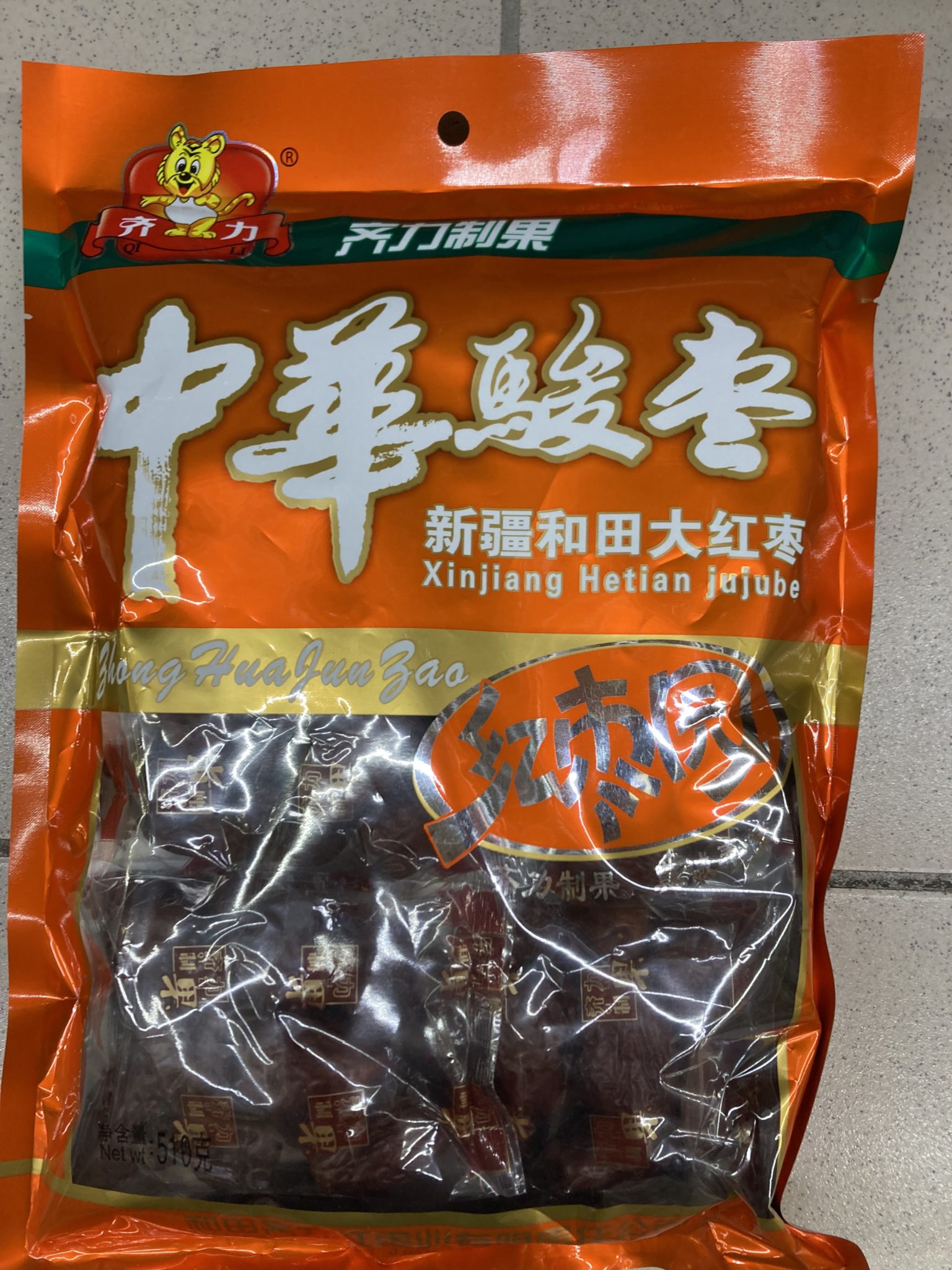
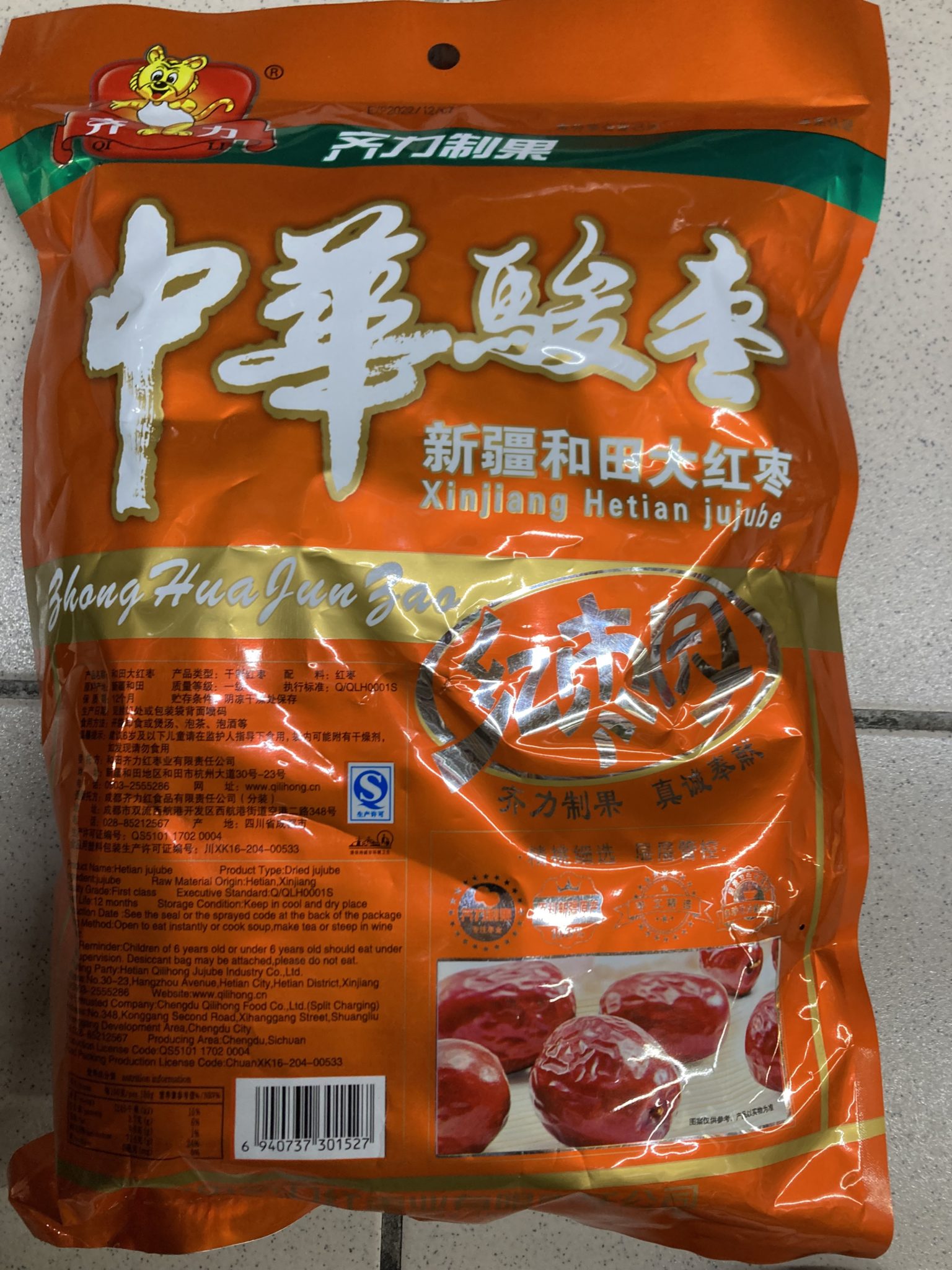
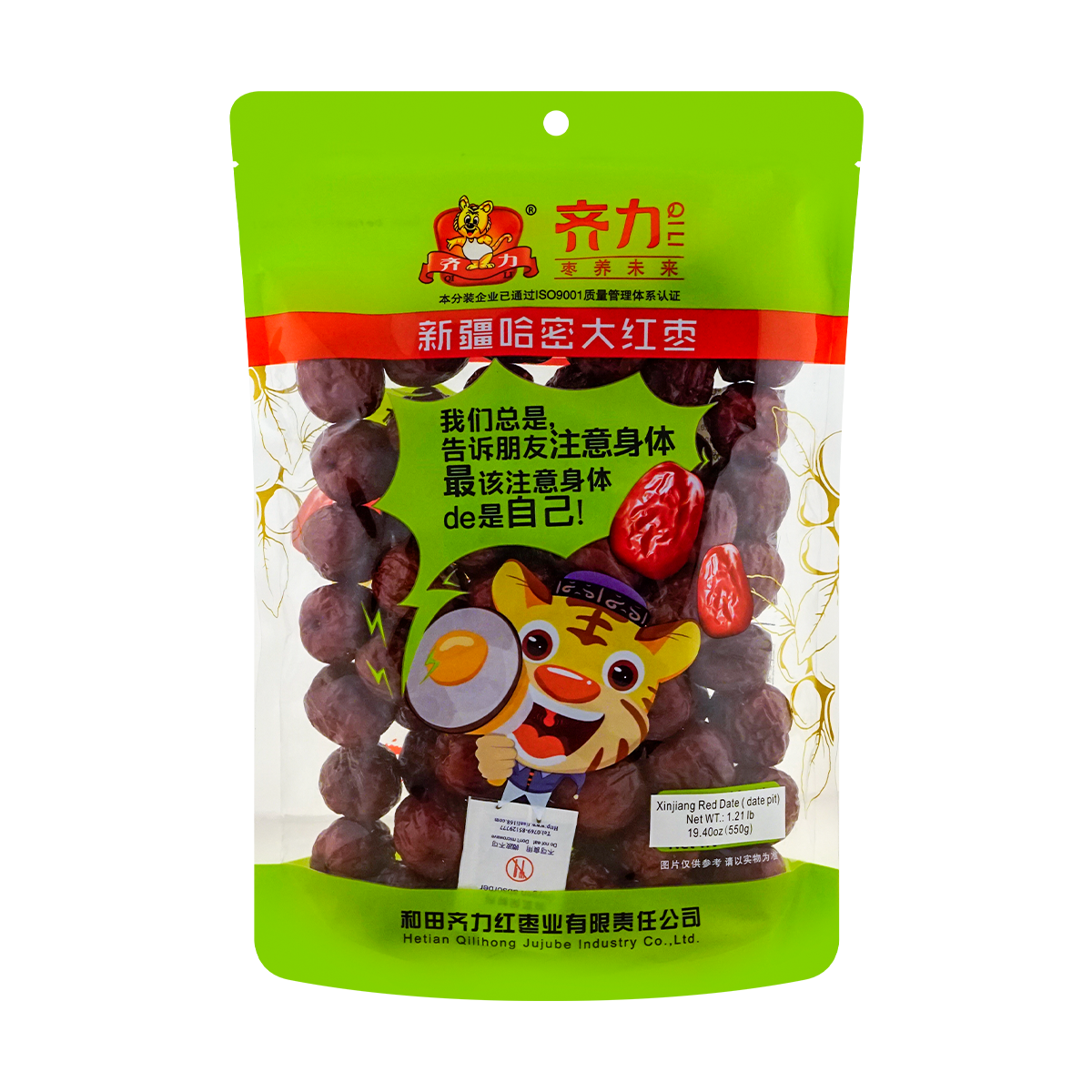
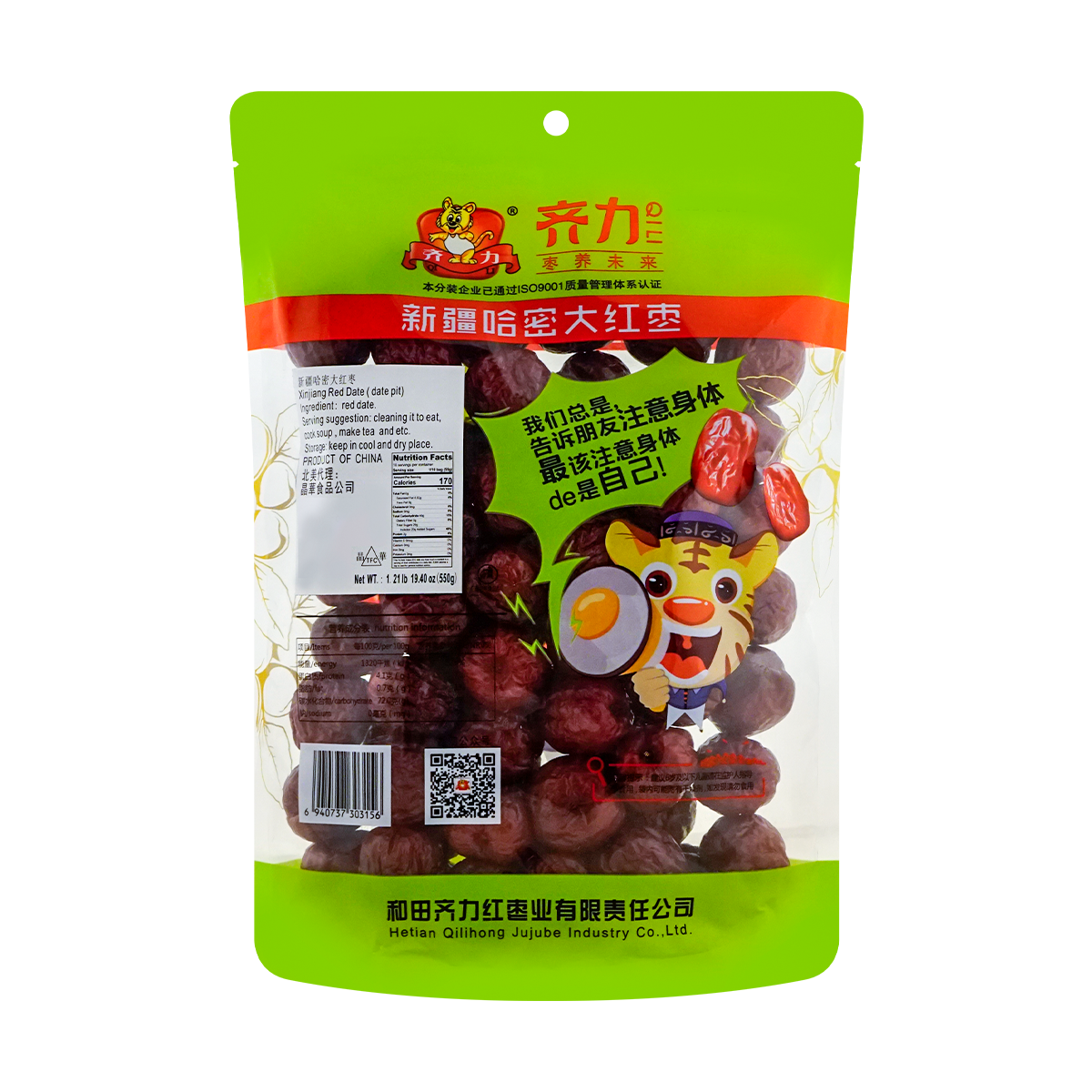
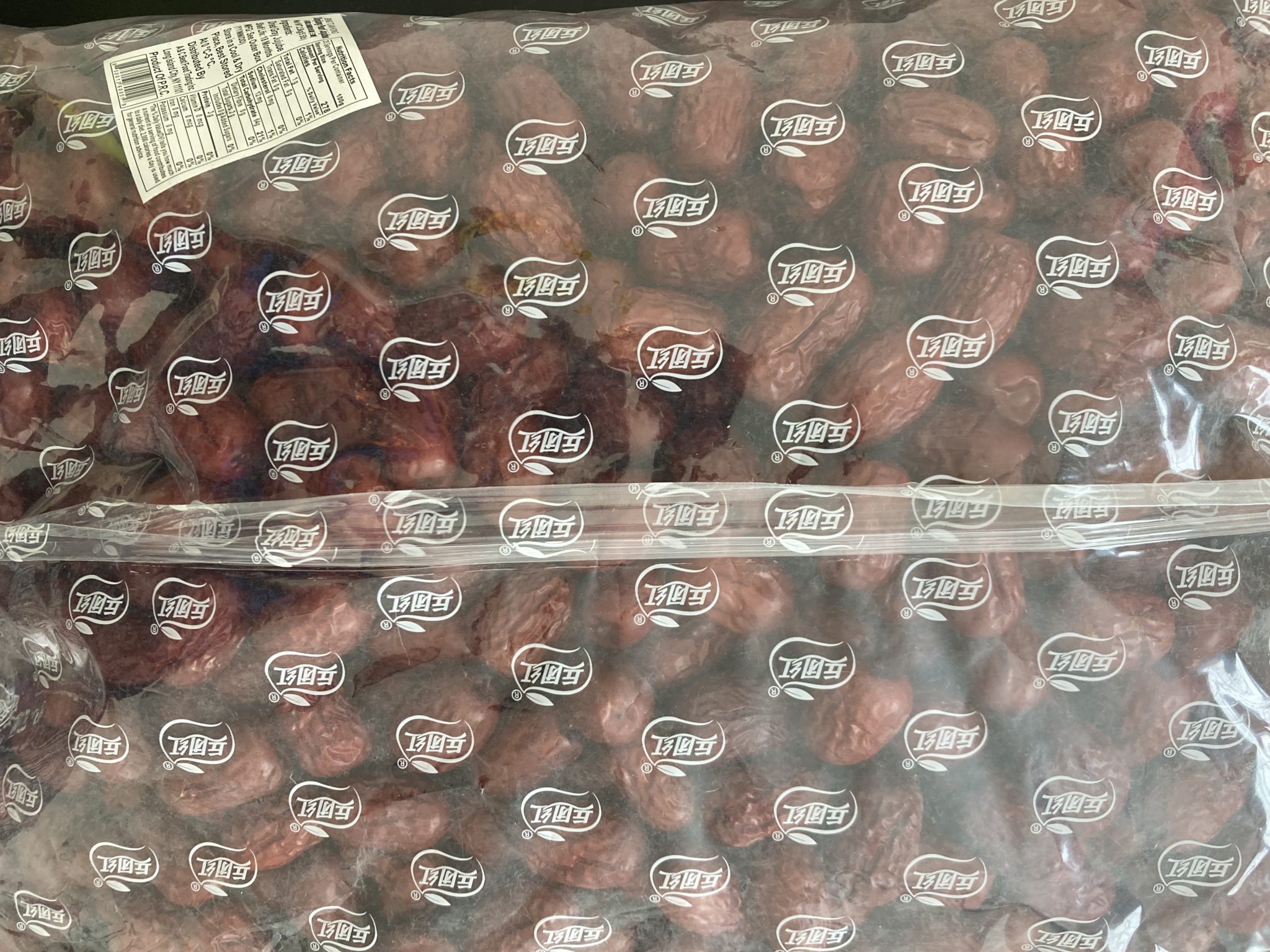

IV. Implications
At least one in five red date products in the global market are made in East Turkistan and may be tainted by forced labor.
The XPCC, the leading producer of red dates in East Turkistan, implements forced labor on a broad scale and is directly linked to mass detentions and surveillance in the region. These and other human rights violations are so egregious that the U.S. government has imposed Global Magnitsky sanctions prohibiting all financial transactions with the XPCC and, since June 2022, import restrictions on all products sourced from the Uyghur Region. Despite these sanctions and enforcement measures, red dates and other fruit products are still available on grocery store shelves.
U.S. retailers and consumers who continue to buy red dates produced in China risk being complicit in forced labor in a region where the Chinese government is committing genocide against Uyghurs.
Now that the UFLPA is in force, U.S. companies that distribute and sell red date products from East Turkistan may face legal consequences if they cannot demonstrate that their supply chain is free of Uyghur forced labor. As urged since July 2020 by the Coalition to End Forced Labor in the Uyghur Region, U.S. companies must map their supply chain at every stage of production, from raw to finished product, if they are to ensure that their products are not sourced from the Uyghur.29Call to Action: Call to action on human rights abuses in the Xinjiang Uyghur Autonomous Region, Coalition to End Forced Labour in the Uyghur Region, https://enduyghurforcedlabour.org/call-to-action In light of limited supply chain traceability and the ongoing genocide in the region, all U.S. brands and retailers should source fruit and other products from suppliers without any links to the Uyghur Region.
Enforcement agencies need to effectively implement the UFLPA and the sanctions against the XPCC to stop banned goods from being imported from a region where massive human rights violations are occurring.

V. Recommendations
To the U.S. government
- Add brands selling red dates sourced from the Uyghur Region to the UFLPA forced labor Entity List;
- Add fruit and fruit products to the high-risk category of the UFLPA Enforcement Strategy; and
- Impose civil and criminal penalties for violations of Global Magnitsky sanctions currently in place, prohibiting all financial transactions with the XPCC and its subsidiaries.
To companies
- Trace supply chains to comply with the UFLPA and end complicity in China’s state-imposed forced labor program.
To consumers
- Check product labels. If the packaging mentions XPCC, “Bingtuan,” or “Xinjiang,” alert the retailer that these products are subject to U.S. sanctions and should not be on store shelves. Contact companies, including distributors, brands, and grocery stores, asking them how they are addressing the risks of Uyghur forced labor.
- Submit CBP trade violation reports for red date products you suspect are sourced from the Uyghur Region at eallegations.cbp.gov/s
- Share details about products sourced from the Uyghur Region with our team by emailing info@uhrp.org
How to Identify Uyghur Red Date Products
- Check the label and product description for keywords: Uyghur, Xinjiang, XPCC, Bingtuan, Kashgar, Aksu, Hotan, Qumul, and Turpan in English, Uyghur, and Chinese. Find a translated list of place names here.
- Check packaging for appropriated cultural symbols: people wearing headscarves or doppas, dancers and musicians, mosques, mountains, and camels.

VI. Background
UHRP’s investigation has found that certain dried fruits and many of the red date products found on shelves in Asian and international groceries in the U.S. are linked both directly and indirectly to forced labor in East Turkistan. The Chinese government’s state-imposed program of forced labor for Uyghurs implicates many industries in China, including cotton and apparel, technology, car production, solar panels, construction supplies, and agriculture.30Vicky Xiuzhong Xu, Danielle Cave, Dr James Leibold, Kelsey Munro, and Nathan Ruser. “Uyghurs for sale: ‘Re-education’, forced labor and surveillance beyond Xinjiang,” Australian Strategic Policy Institute and the International Cyber Policy Center, 2020, accessed on August 5, 2022, https://www.aspi.org.au/report/uyghurs-sale; “Against Their Will: The Situation in Xinjiang,” Bureau of International Labor Affairs, U.S. Department of Labor, 2020, https://www.d ol.gov/agencies/ilab/against-their-will-the-situation-in-xinjiang In 2020, more than 82 global brands with supply chains in East Turkistan were implicated in state-sponsored forced labor, including Apple, Nike, and Volkswagen.31Vicky Xiuzhong Xu, Danielle Cave, Dr James Leibold, Kelsey Munro, and Nathan Ruser. “Uyghurs for sale: ‘Re-education’, forced labor and surveillance beyond Xinjiang,” Australian Strategic Policy Institute and the International Cyber Policy Center, 2020, p. 3, accessed on August 5, 2022, https://www.aspi.org.au/report/uyghurs-sale Today, over 800 companies’ supply chains have been linked to Uyghur forced labor.32“Uyghur Forced Labor Database,” Jewish World Watch, accessed on August 5, 2022, https://jw w.org/site/uyghur-china-forced-labor-database/ Food products, including tomatoes, peppers, and walnuts, are no exception.33Irina Bukharin, “Long Shadows: How the Global Economy Supports Oppression in Xinjiang,” C4ADS, August 2021, p. 4, https://c4ads.org/long-shadows
This briefing reveals that red dates sourced from East Turkistan are at high risk of being tainted by Uyghur forced labor. It analyzes how the XPCC, listed under four different U.S. human rights sanctions, is tied to China’s red date exports.34“U.S. Sanctions List,” Uyghur Human Rights Project, updated March 2022, accessed August 5, 2022, https://uhrp.org/sanctions This briefing identifies brands, distributors, and suppliers that are sourcing red dates from East Turkistan and urges U.S. suppliers and government agencies to stop the import of red dates that are at high risk of being tainted by Uyghur forced labor.
State-Sponsored Forced Labor
The Chinese government has subjected millions of Uyghurs, Kazakhs, and Kyrgyz to forced labor in the Uyghur Region.35Vicky Xiuzhong Xu, Danielle Cave, Dr James Leibold, Kelsey Munro, and Nathan Ruser. “Uyghurs for sale: ‘Re-education’, forced labor and surveillance beyond Xinjiang,” Australian Strategic Policy Institute and the International Cyber Policy Center, 2020, p. 3, accessed on August 5, 2022, https://www.aspi.org.au/report/uyghurs-sale; Adrian Zenz. “Unemployment Monitoring and Early Warning: New Trends in Xinjiang’s Coercive Labor Placement Systems,” Victims of Communism Memorial Foundations, June 5, 2022, accessed August 5, 2022, https://victimsofcommunism.org/publication/unemployment-monitoring-and-early-warning Analysis of government documents shows that the scope and scale of coercive labor transfers for Uyghurs increased in 2021, with an estimated 2 to 2.5 million people currently at risk of forced labor. In its Five Year Plan for 2021–2025, the Chinese government expanded “vocational training” and labor transfer goals with plans to assign everyone who is able to work into work placements.36Adrian Zenz. “Unemployment Monitoring and Early Warning: New Trends in Xinjiang’s Coercive Labor Placement Systems,” Victims of Communism Memorial Foundations, June 5, 2022, accessed August 5, 2022, https://victimsofcommunism.org/publication/unemployment-monitoring-and-early-warning The government offers financial subsidies for companies from across China to open factories in East Turkistan and employ Uyghur detainees and rural “surplus laborers” both in the Uyghur Region and in cities across China.37Vicky Xiuzhong Xu, Danielle Cave, Dr James Leibold, Kelsey Munro, and Nathan Ruser. “Uyghurs for sale: ‘Re-education’, forced labor and surveillance beyond Xinjiang,” Australian Strategic Policy Institute and the International Cyber Policy Center, 2020, p. 15, accessed on August 5, 2022, https://www.aspi.org.au/report/uyghurs-sale
The supply chains of many foreign companies may be directly or indirectly tied to Uyghur forced labor. Over 800,000 companies in 147 countries, 2,114 of them based in the U.S., have been directly linked to the XPCC.38 Irina Bukharin, “Long Shadows: How the Global Economy Supports Oppression in Xinjiang,” C4ADS, August 2021, https://c4ads.org/long-shadows; Sayari, “U.S.-Sanctioned Xinjiang Paramilitary,” August 4, 2020. The XPCC is a major perpetrator of human rights abuses, including mass internment, surveillance, population transfers, and forced labor in East Turkistan, operating farms, ranches, and holding companies.39“The Bingtuan: China’s Paramilitary Colonizing Force in East Turkestan,” Uyghur Human Rights Projects, April 2018, https://uhrp.org/report/uhrp-releases-new-report-bingtuan-chinas-paramilitary-colonizing-force-east; Irina Bukharin, “Long Shadows: How the Global Economy Supports Oppression in Xinjiang,” C4ADS, August 2021, https://c4ads.org/long-shadows; “2019 Xinjiang Production and Construction Corps Statistical Yearbook,” Table 9-1, p. 217, China Statistics Press, 2018, https://www.shahit.biz/yearbooks/2019%20Bingtuan%20Statistica l%20Yearbook.pdf According to the Center for Advanced Defense Studies (C4ADS), the XPCC owns more than 50 percent of at least 13 red date companies in China.40Irina Bukharin, “Long Shadows: How the Global Economy Supports Oppression in Xinjiang,” C4ADS, August 2021, https://c4ads.org/long-shadows Therefore, there is a high risk that the red dates in U.S. and international markets are tainted by Uyghur forced labor.
U.S. Government Policy
The Uyghur Forced Labor Prevention Act (UFLPA), which went into effect on June 21, 2022, requires the U.S. to detain, exclude, or seize any imports that originate, in whole or in part, in the Uyghur Region, or are made using the forced labor of Uyghurs and other Turkic peoples anywhere in China. Companies are responsible for conducting due diligence and demonstrating by “clear and convincing evidence” that their goods were not made with forced labor.41“Operational Guidance for Importers,” U.S. Customs and Border Protection, June 13, 2022, https://www.cbp.gov/document/guidance/uflpa-operational-guidance-importers; See also: “Strategy to Prevent the Importation of Goods Mined, Produced, or Manufactured with Forced Labor in the People’s Republic of China,”, June 17, 2022, https://www.dhs.gov/uflpa-strategy; “Xinjiang Uyghur Autonomous Region WRO Frequently Asked Questions,” U.S. Customs and Border Protection, undated, https://www.cbp.gov/trade/programs-administration/forced-labor/xinjiang-uyghur-autonomous-region-wro-frequently-asked-questions?language_con tent_entity=en
Since July 31, 2020, the XPCC has been under Global Magnitsky Sanctions, prohibiting U.S. persons from conducting any transactions involving the XPCC, including any provision of funds, goods, or services.42U.S. Department of the Treasury, Office of Foreign Assets Control (OFAC), “Treasury Sanctions Chinese Entity and Officials Pursuant to Global Magnitsky Human Rights Executive Order,” July 31, 2020, accessed Aug 5, 2022, https://home.treasury.gov/news/press-releases/sm1073. The sanctions were imposed for the XPCC’s connection to comprehensive surveillance, detention, mass arbitrary detention and severe physical abuse, among other serious abuses targeting Uyghurs. Despite the imposition of Global Magnitsky sanctions on the XPCC, products with the XPCC label continue to reach grocery store shelves in the U.S.
Case Studies
Blooming Import and Growland are the largest distributors of red date products sold in grocery stores in the Washington, D.C. metropolitan area.
Blooming Import is a U.S. wholesaler based in Brooklyn, NY that sells Chinese food and snacks.43See: Import Yeti, “Blooming Import,” https://www.importyeti.com/company/blooming-import It sells Farmer Brand and Golden Lion red date products. A number of D.C. grocery stores carry its products, including 99 Ranch Market, Lotte Plaza Market, Fresh World, H Mart, LA Mart, Great Wall Supermarket, and Good Fortune Supermarket. Online grocery stores including sayweee.com and justasianfood.com also sell products from Bloomington Import. Blooming Import purchases red date products from Taishan City Daxin Food Co., Ltd. in Guangdong Province in China. Trade data shows Taishan City Daxin Food Co., Ltd. sent over 200 shipments of red date products to Blooming Import from 2015 to 2022, including 39 shipments in 2020, 40 shipments in 2021, and 25 in 2022.44See: Import Yeti, “Blooming Import,” https://www.importyeti.com/company/blooming-import ; C4ADS. Most recently, Bloomington Import received a shipment of over 17,000 kg of dried dates from Taishan City Daxin Food Co., Ltd. in June 2022.45See: Import Yeti, “Blooming Import,” https://www.importyeti.com/company/blooming-import
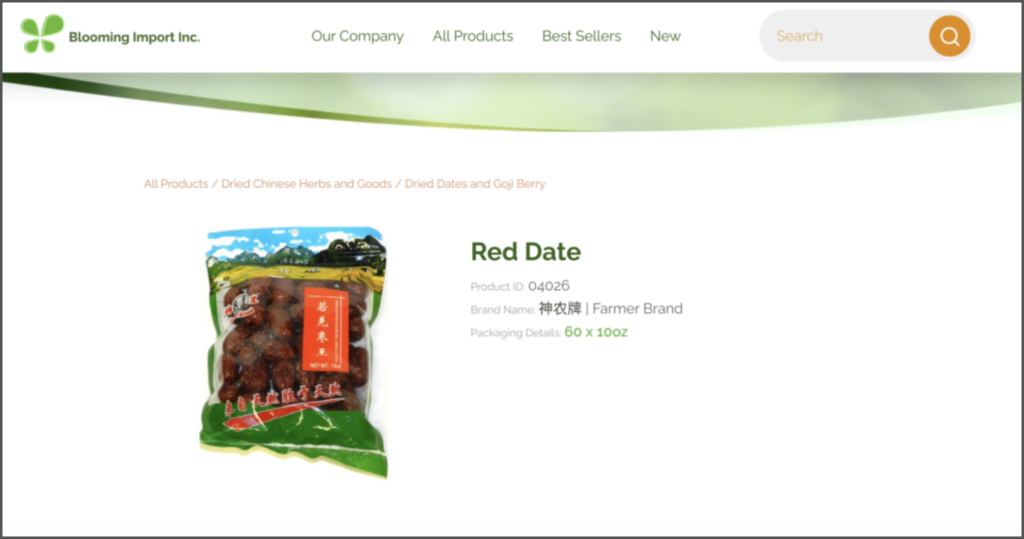
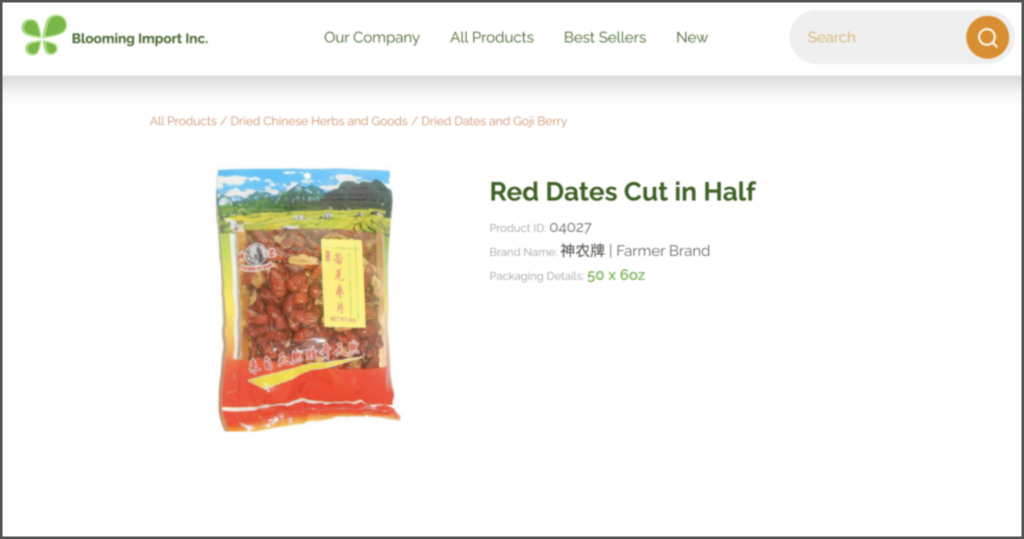
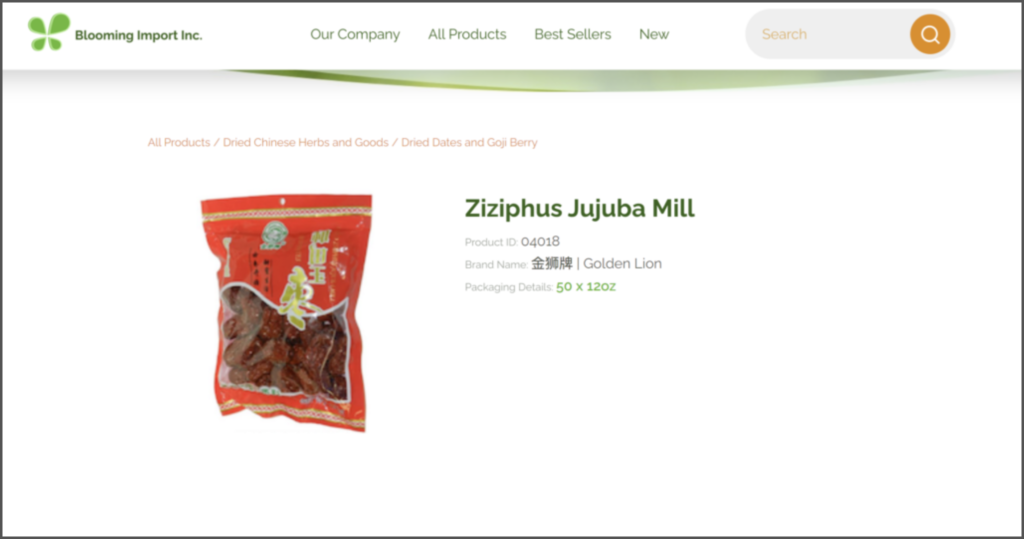
Growland is a U.S. distributor and brand based in Chino, CA that sells red date, goji berry, and mushroom products from China.46See: Import Yeti, “Growland,” https://www.importyeti.com/company/growland Growland has on online outlet (growland.shop) that currently ships eight red date products from East Turkistan (Aqsu, Ruoqiang [Kargilik], Khotan [(Hotan], Hami [Qumul], and Xinjiang) and one raisin product from Turpan under the category of “Chinese Health Center.”47See: Growland, https://growland.shop/ Growland brand products are found on the shelves of 99 Ranch Market and online at sayweee.com.
Trade data shows Growland purchased red date products from Gansu Growland Agriculture Development and from Yanchuan Senhai Agricultural Production.48See: Import Yeti, “Growland,” https://www.importyeti.com/company/growland Growland received at least ten shipments of red date products from Yanchuan Senhai Agricultural Production in Shaanxi Province from 2017 to 2018.49 See: Import Yeti, “Growland,” https://www.importyeti.com/company/growland; C4ADS. Growland received 14 shipments of red date products from Gansu Growland Agricultural Development in Gansu Province from 2018 to 2022.50See: Import Yeti, “Growland,” https://www.importyeti.com/company/growland Gansu Growland most recently shipped over 39,000 kg of red date products to Growland in July 2022.
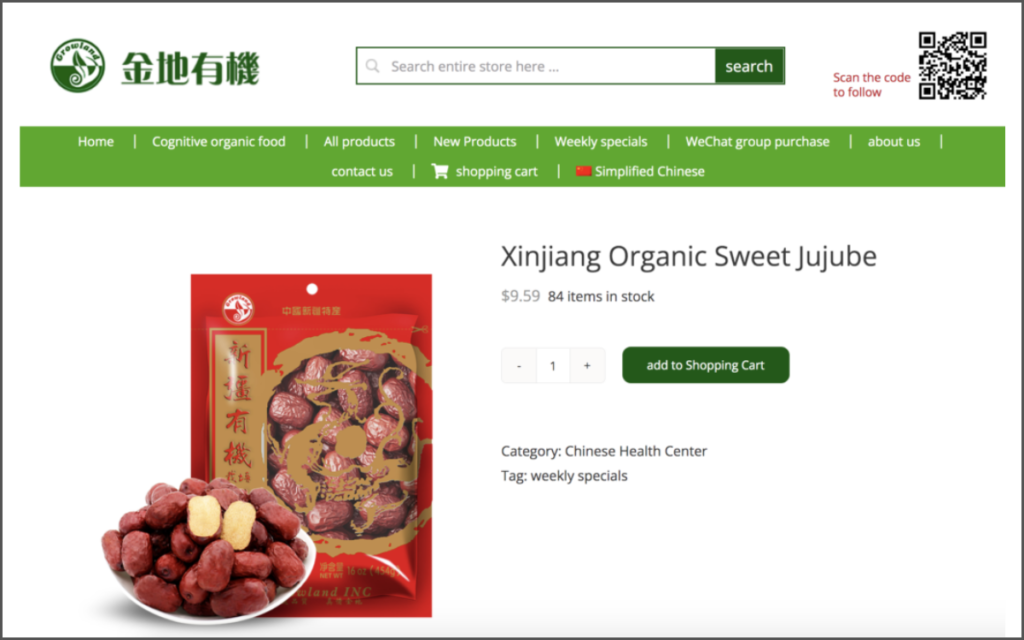
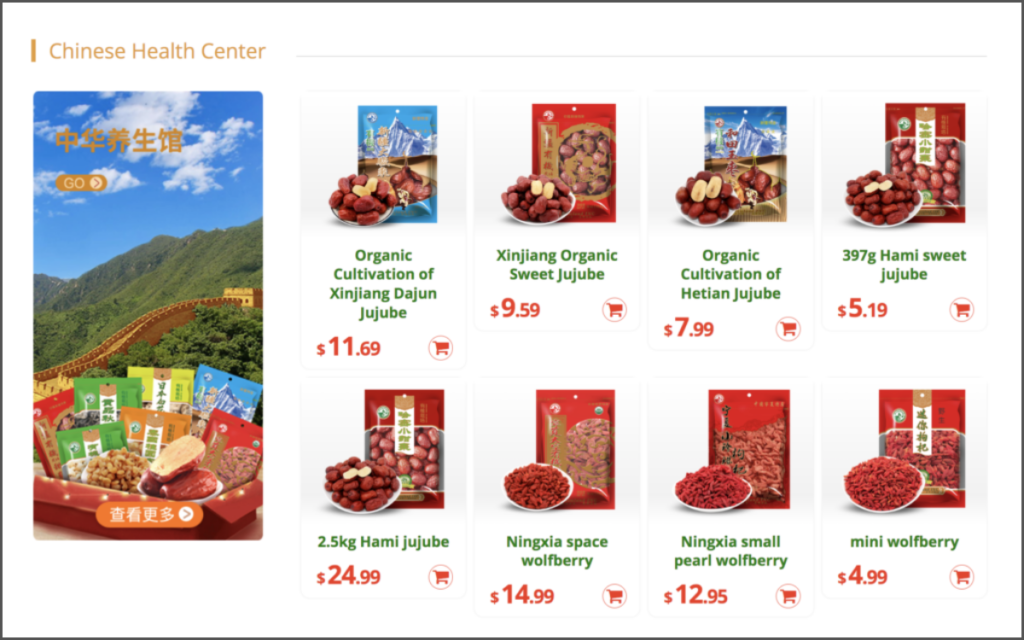

VII. Acknowledgements
The author is grateful to Henryk Szadziewski and Elise Anderson for their guidance and feedback on research design and data presentation. The author also appreciates Irina Bukharin, Nicole Morgret, Laura Murphy, and Charlotte Tate for their insights and support. She also thanks Louisa Greve, Peter Irwin, and Ben Carrdus for reviewing and providing constructive feedback on the report.

VIII. About the Author
“Fruits of Forced Labor in American Grocery Stores” was researched and written by Nuzigum Setiwaldi. Nuzigum Setiwaldi is a campaign associate with the Coalition to End Uyghur Forced Labour and a content manager with USAHello. She holds a degree in sociology and is interested in human rights research and immigrant rights.
FEATURED VIDEO
Atrocities Against Women in East Turkistan: Uyghur Women and Religious Persecution
Watch UHRP's event marking International Women’s Day with a discussion highlighting ongoing atrocities against Uyghur and other Turkic women in East Turkistan.


